A Critical Evaluation of Westpac Institutional Bank's Credit Processes
VerifiedAdded on 2019/10/31
|27
|7914
|26
Thesis and Dissertation
AI Summary
This dissertation critically evaluates the operational and process management within Westpac Institutional Bank's credit processes in Singapore, focusing on increasing the speed to market from origination to execution. The research explores the background of Westpac's operations in Singapore, identifies the research problem of slow credit processes, and poses key research questions regarding control processes, the causes of sluggishness, methods to limit breakdowns, and the adequacy of credit management. The literature review covers process and operations management, credit process management, credit technology, and risk assessment. The methodology includes data collection via surveys and interviews, along with data analysis to identify undesirable outcomes and suggest improvements to the credit process. The findings aim to provide recommendations for enhancing Westpac's credit processes, ultimately contributing to improved efficiency and competitiveness in the Singapore market. The study also highlights the importance of technology, accountability, and process optimization in the banking sector.
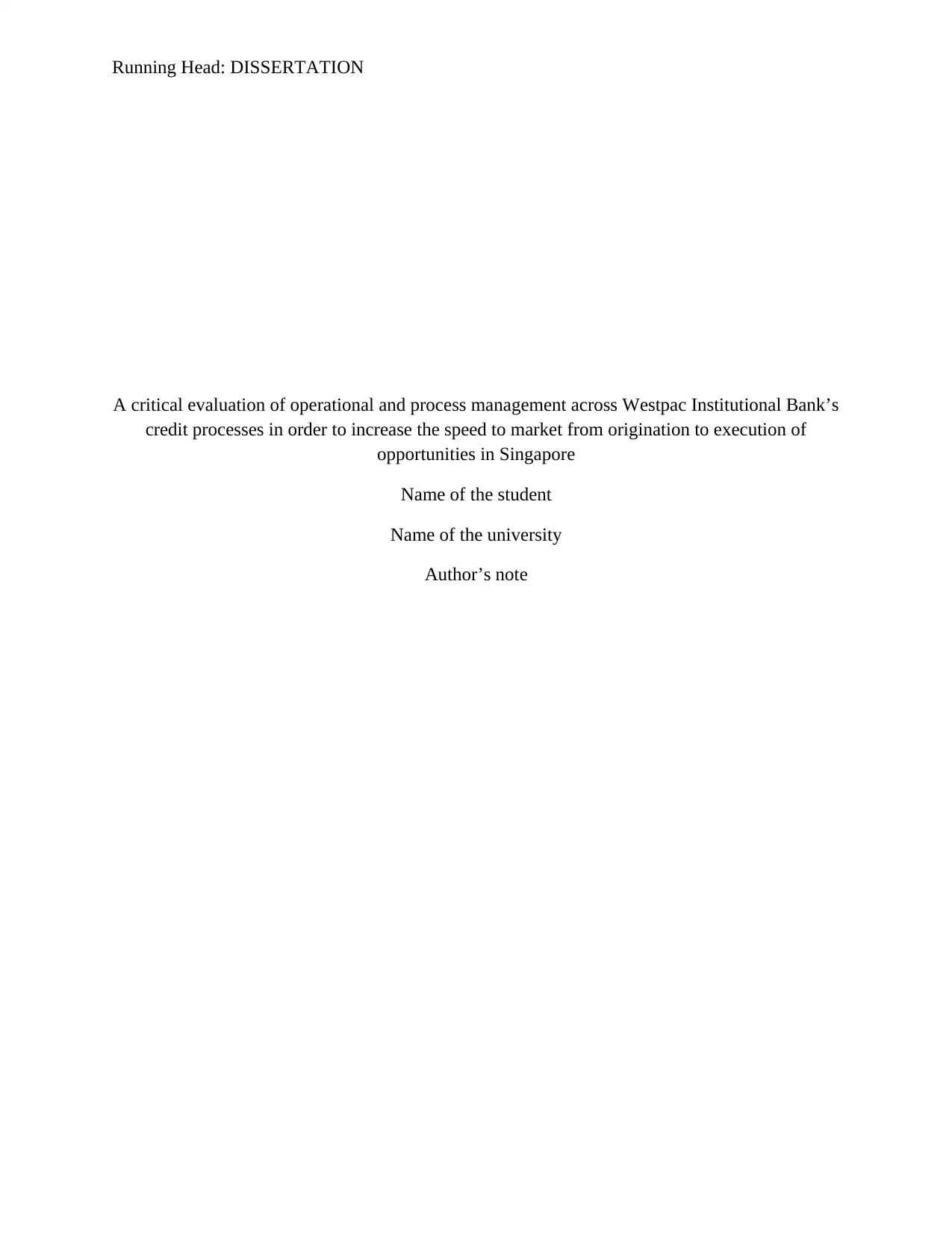
Running Head: DISSERTATION
A critical evaluation of operational and process management across Westpac Institutional Bank’s
credit processes in order to increase the speed to market from origination to execution of
opportunities in Singapore
Name of the student
Name of the university
Author’s note
A critical evaluation of operational and process management across Westpac Institutional Bank’s
credit processes in order to increase the speed to market from origination to execution of
opportunities in Singapore
Name of the student
Name of the university
Author’s note
Paraphrase This Document
Need a fresh take? Get an instant paraphrase of this document with our AI Paraphraser
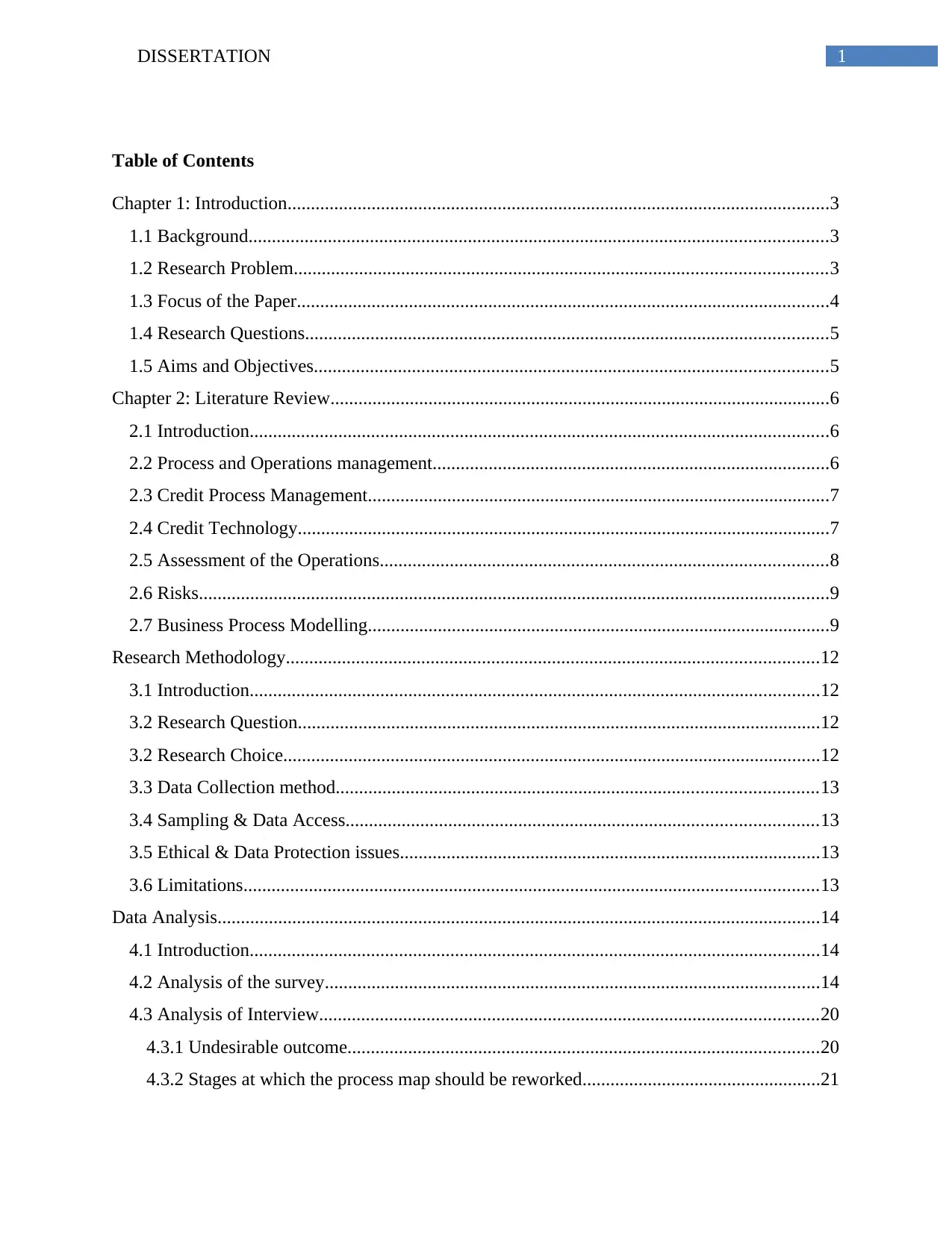
1DISSERTATION
Table of Contents
Chapter 1: Introduction....................................................................................................................3
1.1 Background............................................................................................................................3
1.2 Research Problem..................................................................................................................3
1.3 Focus of the Paper..................................................................................................................4
1.4 Research Questions................................................................................................................5
1.5 Aims and Objectives..............................................................................................................5
Chapter 2: Literature Review...........................................................................................................6
2.1 Introduction............................................................................................................................6
2.2 Process and Operations management.....................................................................................6
2.3 Credit Process Management...................................................................................................7
2.4 Credit Technology..................................................................................................................7
2.5 Assessment of the Operations................................................................................................8
2.6 Risks.......................................................................................................................................9
2.7 Business Process Modelling...................................................................................................9
Research Methodology..................................................................................................................12
3.1 Introduction..........................................................................................................................12
3.2 Research Question................................................................................................................12
3.2 Research Choice...................................................................................................................12
3.3 Data Collection method.......................................................................................................13
3.4 Sampling & Data Access.....................................................................................................13
3.5 Ethical & Data Protection issues..........................................................................................13
3.6 Limitations...........................................................................................................................13
Data Analysis.................................................................................................................................14
4.1 Introduction..........................................................................................................................14
4.2 Analysis of the survey..........................................................................................................14
4.3 Analysis of Interview...........................................................................................................20
4.3.1 Undesirable outcome.....................................................................................................20
4.3.2 Stages at which the process map should be reworked...................................................21
Table of Contents
Chapter 1: Introduction....................................................................................................................3
1.1 Background............................................................................................................................3
1.2 Research Problem..................................................................................................................3
1.3 Focus of the Paper..................................................................................................................4
1.4 Research Questions................................................................................................................5
1.5 Aims and Objectives..............................................................................................................5
Chapter 2: Literature Review...........................................................................................................6
2.1 Introduction............................................................................................................................6
2.2 Process and Operations management.....................................................................................6
2.3 Credit Process Management...................................................................................................7
2.4 Credit Technology..................................................................................................................7
2.5 Assessment of the Operations................................................................................................8
2.6 Risks.......................................................................................................................................9
2.7 Business Process Modelling...................................................................................................9
Research Methodology..................................................................................................................12
3.1 Introduction..........................................................................................................................12
3.2 Research Question................................................................................................................12
3.2 Research Choice...................................................................................................................12
3.3 Data Collection method.......................................................................................................13
3.4 Sampling & Data Access.....................................................................................................13
3.5 Ethical & Data Protection issues..........................................................................................13
3.6 Limitations...........................................................................................................................13
Data Analysis.................................................................................................................................14
4.1 Introduction..........................................................................................................................14
4.2 Analysis of the survey..........................................................................................................14
4.3 Analysis of Interview...........................................................................................................20
4.3.1 Undesirable outcome.....................................................................................................20
4.3.2 Stages at which the process map should be reworked...................................................21
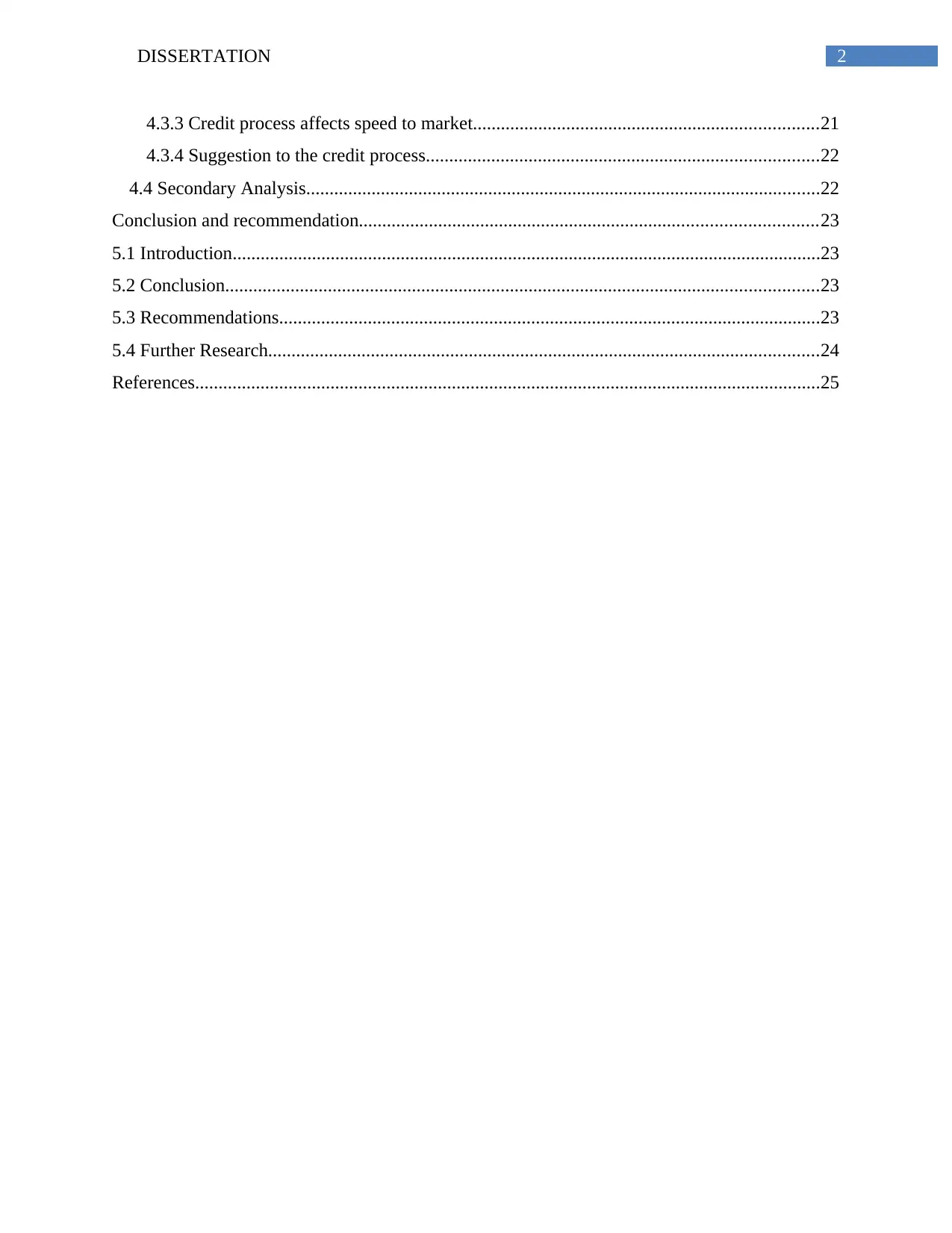
2DISSERTATION
4.3.3 Credit process affects speed to market..........................................................................21
4.3.4 Suggestion to the credit process....................................................................................22
4.4 Secondary Analysis..............................................................................................................22
Conclusion and recommendation..................................................................................................23
5.1 Introduction..............................................................................................................................23
5.2 Conclusion...............................................................................................................................23
5.3 Recommendations....................................................................................................................23
5.4 Further Research......................................................................................................................24
References......................................................................................................................................25
4.3.3 Credit process affects speed to market..........................................................................21
4.3.4 Suggestion to the credit process....................................................................................22
4.4 Secondary Analysis..............................................................................................................22
Conclusion and recommendation..................................................................................................23
5.1 Introduction..............................................................................................................................23
5.2 Conclusion...............................................................................................................................23
5.3 Recommendations....................................................................................................................23
5.4 Further Research......................................................................................................................24
References......................................................................................................................................25
You're viewing a preview
Unlock full access by subscribing today!
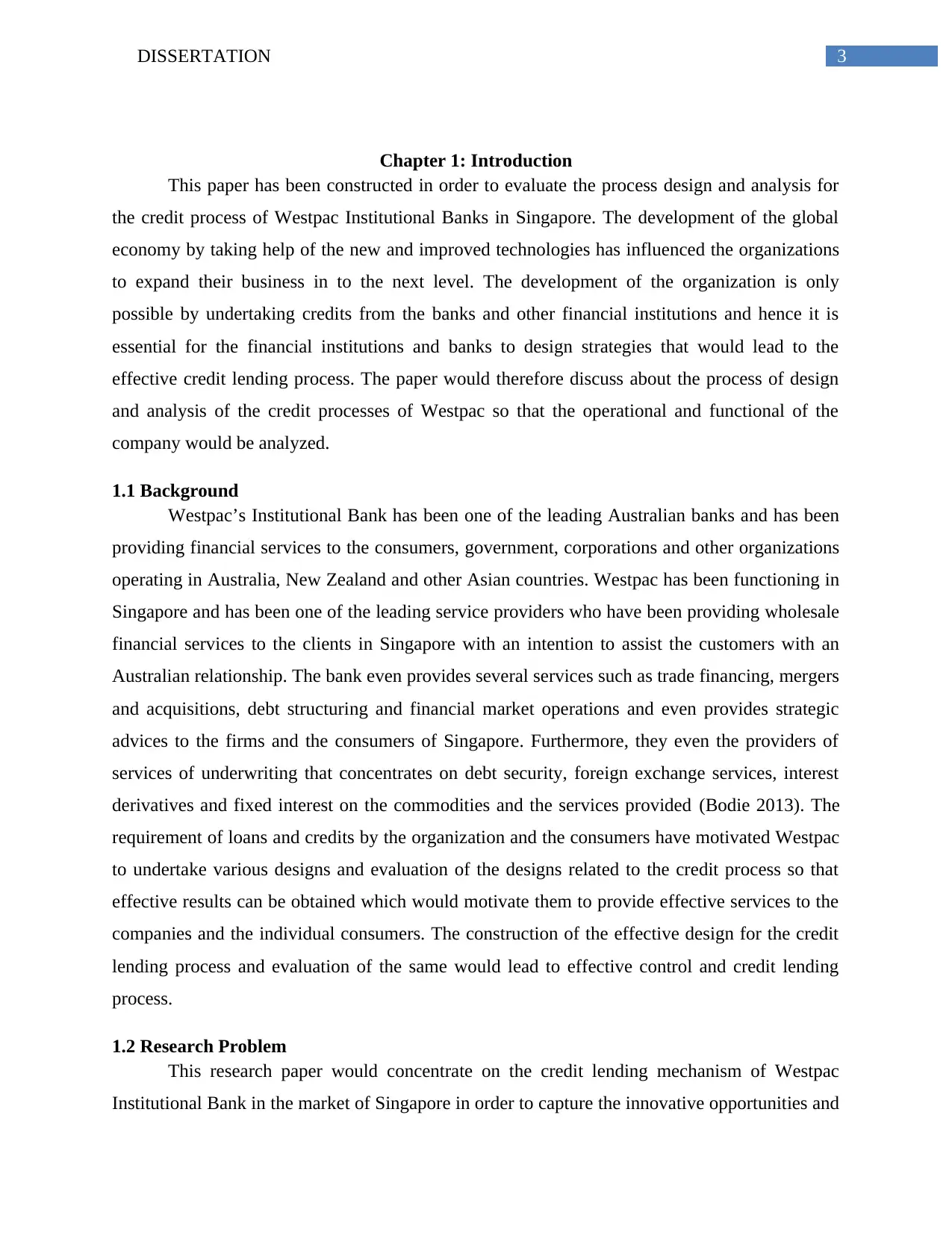
3DISSERTATION
Chapter 1: Introduction
This paper has been constructed in order to evaluate the process design and analysis for
the credit process of Westpac Institutional Banks in Singapore. The development of the global
economy by taking help of the new and improved technologies has influenced the organizations
to expand their business in to the next level. The development of the organization is only
possible by undertaking credits from the banks and other financial institutions and hence it is
essential for the financial institutions and banks to design strategies that would lead to the
effective credit lending process. The paper would therefore discuss about the process of design
and analysis of the credit processes of Westpac so that the operational and functional of the
company would be analyzed.
1.1 Background
Westpac’s Institutional Bank has been one of the leading Australian banks and has been
providing financial services to the consumers, government, corporations and other organizations
operating in Australia, New Zealand and other Asian countries. Westpac has been functioning in
Singapore and has been one of the leading service providers who have been providing wholesale
financial services to the clients in Singapore with an intention to assist the customers with an
Australian relationship. The bank even provides several services such as trade financing, mergers
and acquisitions, debt structuring and financial market operations and even provides strategic
advices to the firms and the consumers of Singapore. Furthermore, they even the providers of
services of underwriting that concentrates on debt security, foreign exchange services, interest
derivatives and fixed interest on the commodities and the services provided (Bodie 2013). The
requirement of loans and credits by the organization and the consumers have motivated Westpac
to undertake various designs and evaluation of the designs related to the credit process so that
effective results can be obtained which would motivate them to provide effective services to the
companies and the individual consumers. The construction of the effective design for the credit
lending process and evaluation of the same would lead to effective control and credit lending
process.
1.2 Research Problem
This research paper would concentrate on the credit lending mechanism of Westpac
Institutional Bank in the market of Singapore in order to capture the innovative opportunities and
Chapter 1: Introduction
This paper has been constructed in order to evaluate the process design and analysis for
the credit process of Westpac Institutional Banks in Singapore. The development of the global
economy by taking help of the new and improved technologies has influenced the organizations
to expand their business in to the next level. The development of the organization is only
possible by undertaking credits from the banks and other financial institutions and hence it is
essential for the financial institutions and banks to design strategies that would lead to the
effective credit lending process. The paper would therefore discuss about the process of design
and analysis of the credit processes of Westpac so that the operational and functional of the
company would be analyzed.
1.1 Background
Westpac’s Institutional Bank has been one of the leading Australian banks and has been
providing financial services to the consumers, government, corporations and other organizations
operating in Australia, New Zealand and other Asian countries. Westpac has been functioning in
Singapore and has been one of the leading service providers who have been providing wholesale
financial services to the clients in Singapore with an intention to assist the customers with an
Australian relationship. The bank even provides several services such as trade financing, mergers
and acquisitions, debt structuring and financial market operations and even provides strategic
advices to the firms and the consumers of Singapore. Furthermore, they even the providers of
services of underwriting that concentrates on debt security, foreign exchange services, interest
derivatives and fixed interest on the commodities and the services provided (Bodie 2013). The
requirement of loans and credits by the organization and the consumers have motivated Westpac
to undertake various designs and evaluation of the designs related to the credit process so that
effective results can be obtained which would motivate them to provide effective services to the
companies and the individual consumers. The construction of the effective design for the credit
lending process and evaluation of the same would lead to effective control and credit lending
process.
1.2 Research Problem
This research paper would concentrate on the credit lending mechanism of Westpac
Institutional Bank in the market of Singapore in order to capture the innovative opportunities and
Paraphrase This Document
Need a fresh take? Get an instant paraphrase of this document with our AI Paraphraser
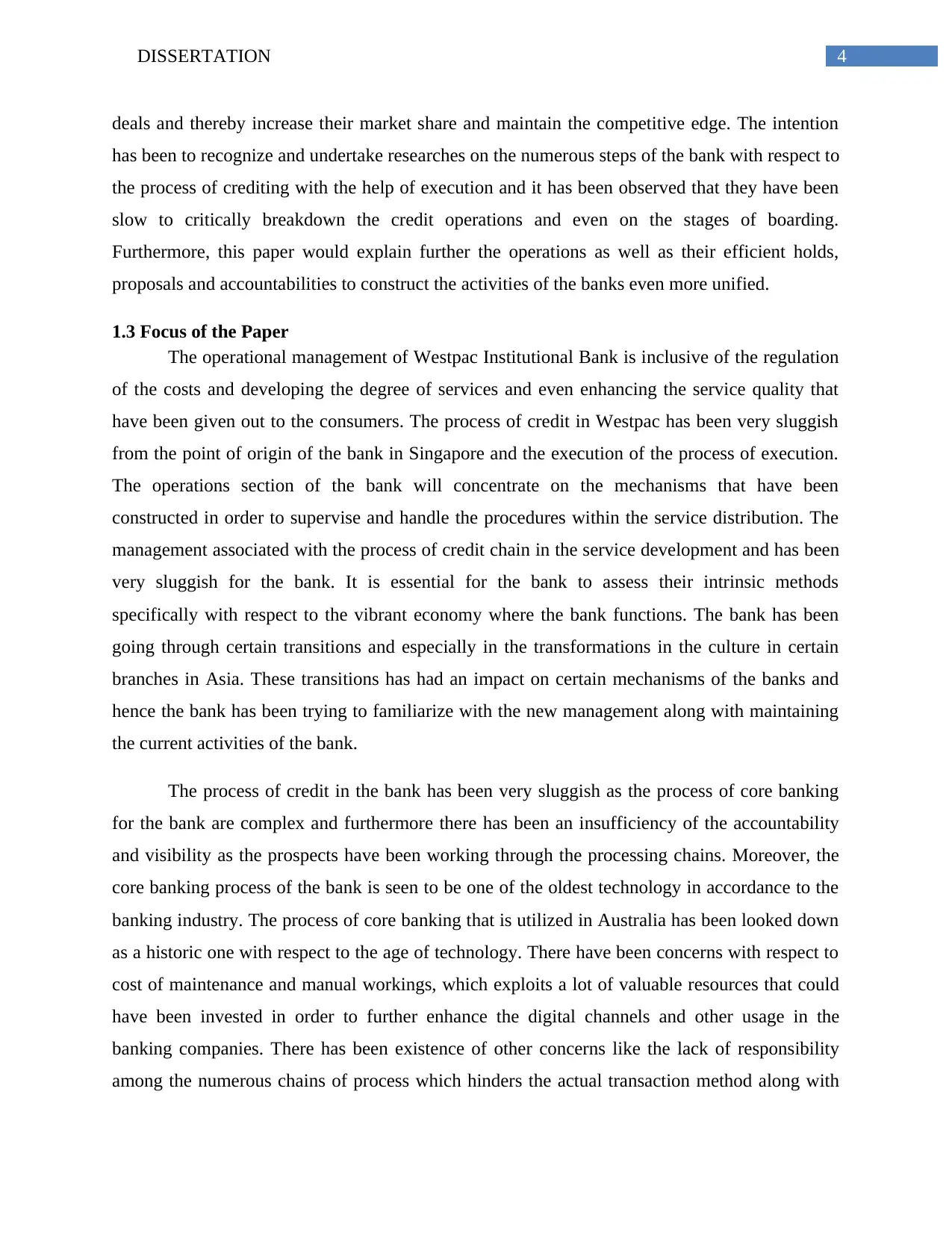
4DISSERTATION
deals and thereby increase their market share and maintain the competitive edge. The intention
has been to recognize and undertake researches on the numerous steps of the bank with respect to
the process of crediting with the help of execution and it has been observed that they have been
slow to critically breakdown the credit operations and even on the stages of boarding.
Furthermore, this paper would explain further the operations as well as their efficient holds,
proposals and accountabilities to construct the activities of the banks even more unified.
1.3 Focus of the Paper
The operational management of Westpac Institutional Bank is inclusive of the regulation
of the costs and developing the degree of services and even enhancing the service quality that
have been given out to the consumers. The process of credit in Westpac has been very sluggish
from the point of origin of the bank in Singapore and the execution of the process of execution.
The operations section of the bank will concentrate on the mechanisms that have been
constructed in order to supervise and handle the procedures within the service distribution. The
management associated with the process of credit chain in the service development and has been
very sluggish for the bank. It is essential for the bank to assess their intrinsic methods
specifically with respect to the vibrant economy where the bank functions. The bank has been
going through certain transitions and especially in the transformations in the culture in certain
branches in Asia. These transitions has had an impact on certain mechanisms of the banks and
hence the bank has been trying to familiarize with the new management along with maintaining
the current activities of the bank.
The process of credit in the bank has been very sluggish as the process of core banking
for the bank are complex and furthermore there has been an insufficiency of the accountability
and visibility as the prospects have been working through the processing chains. Moreover, the
core banking process of the bank is seen to be one of the oldest technology in accordance to the
banking industry. The process of core banking that is utilized in Australia has been looked down
as a historic one with respect to the age of technology. There have been concerns with respect to
cost of maintenance and manual workings, which exploits a lot of valuable resources that could
have been invested in order to further enhance the digital channels and other usage in the
banking companies. There has been existence of other concerns like the lack of responsibility
among the numerous chains of process which hinders the actual transaction method along with
deals and thereby increase their market share and maintain the competitive edge. The intention
has been to recognize and undertake researches on the numerous steps of the bank with respect to
the process of crediting with the help of execution and it has been observed that they have been
slow to critically breakdown the credit operations and even on the stages of boarding.
Furthermore, this paper would explain further the operations as well as their efficient holds,
proposals and accountabilities to construct the activities of the banks even more unified.
1.3 Focus of the Paper
The operational management of Westpac Institutional Bank is inclusive of the regulation
of the costs and developing the degree of services and even enhancing the service quality that
have been given out to the consumers. The process of credit in Westpac has been very sluggish
from the point of origin of the bank in Singapore and the execution of the process of execution.
The operations section of the bank will concentrate on the mechanisms that have been
constructed in order to supervise and handle the procedures within the service distribution. The
management associated with the process of credit chain in the service development and has been
very sluggish for the bank. It is essential for the bank to assess their intrinsic methods
specifically with respect to the vibrant economy where the bank functions. The bank has been
going through certain transitions and especially in the transformations in the culture in certain
branches in Asia. These transitions has had an impact on certain mechanisms of the banks and
hence the bank has been trying to familiarize with the new management along with maintaining
the current activities of the bank.
The process of credit in the bank has been very sluggish as the process of core banking
for the bank are complex and furthermore there has been an insufficiency of the accountability
and visibility as the prospects have been working through the processing chains. Moreover, the
core banking process of the bank is seen to be one of the oldest technology in accordance to the
banking industry. The process of core banking that is utilized in Australia has been looked down
as a historic one with respect to the age of technology. There have been concerns with respect to
cost of maintenance and manual workings, which exploits a lot of valuable resources that could
have been invested in order to further enhance the digital channels and other usage in the
banking companies. There has been existence of other concerns like the lack of responsibility
among the numerous chains of process which hinders the actual transaction method along with
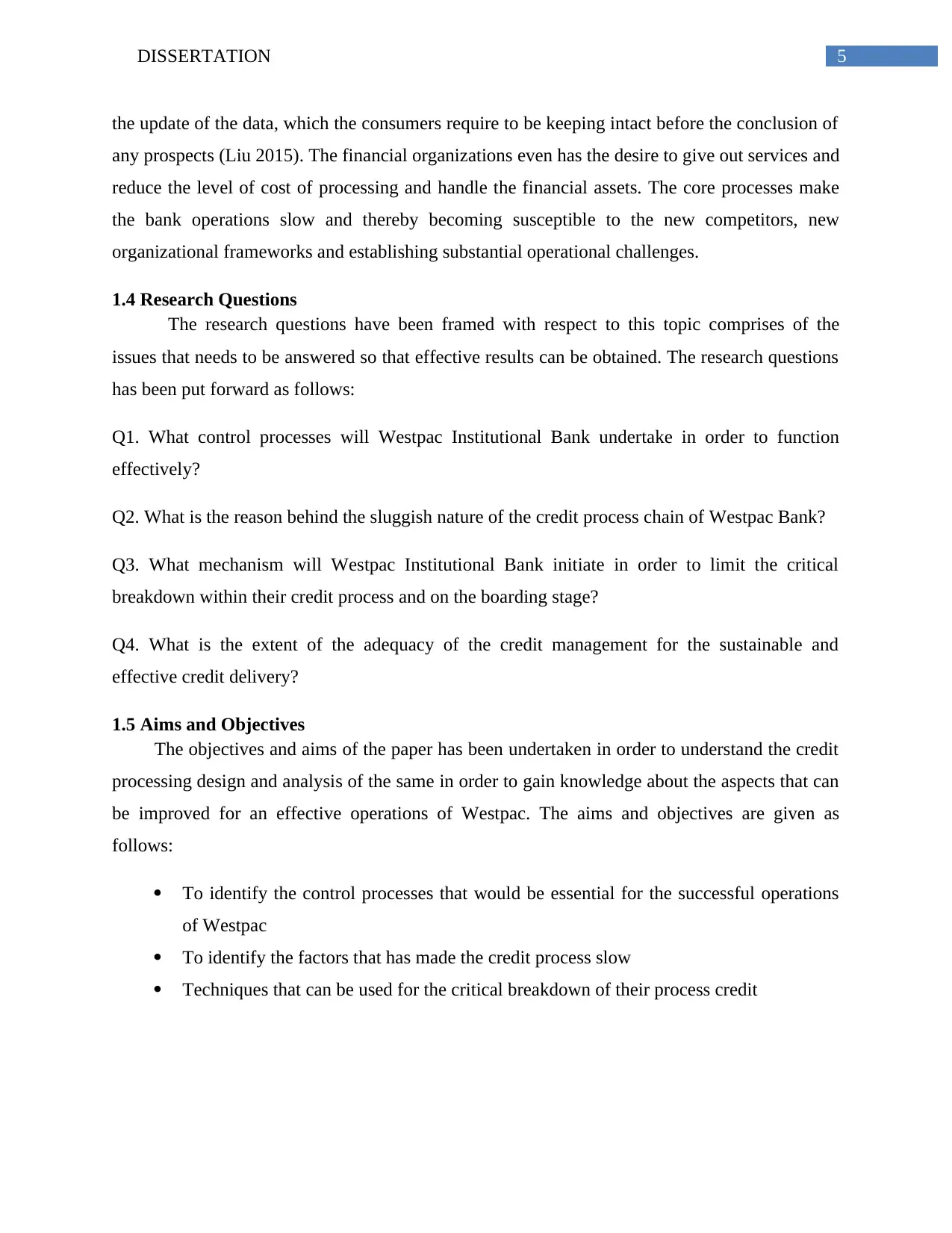
5DISSERTATION
the update of the data, which the consumers require to be keeping intact before the conclusion of
any prospects (Liu 2015). The financial organizations even has the desire to give out services and
reduce the level of cost of processing and handle the financial assets. The core processes make
the bank operations slow and thereby becoming susceptible to the new competitors, new
organizational frameworks and establishing substantial operational challenges.
1.4 Research Questions
The research questions have been framed with respect to this topic comprises of the
issues that needs to be answered so that effective results can be obtained. The research questions
has been put forward as follows:
Q1. What control processes will Westpac Institutional Bank undertake in order to function
effectively?
Q2. What is the reason behind the sluggish nature of the credit process chain of Westpac Bank?
Q3. What mechanism will Westpac Institutional Bank initiate in order to limit the critical
breakdown within their credit process and on the boarding stage?
Q4. What is the extent of the adequacy of the credit management for the sustainable and
effective credit delivery?
1.5 Aims and Objectives
The objectives and aims of the paper has been undertaken in order to understand the credit
processing design and analysis of the same in order to gain knowledge about the aspects that can
be improved for an effective operations of Westpac. The aims and objectives are given as
follows:
To identify the control processes that would be essential for the successful operations
of Westpac
To identify the factors that has made the credit process slow
Techniques that can be used for the critical breakdown of their process credit
the update of the data, which the consumers require to be keeping intact before the conclusion of
any prospects (Liu 2015). The financial organizations even has the desire to give out services and
reduce the level of cost of processing and handle the financial assets. The core processes make
the bank operations slow and thereby becoming susceptible to the new competitors, new
organizational frameworks and establishing substantial operational challenges.
1.4 Research Questions
The research questions have been framed with respect to this topic comprises of the
issues that needs to be answered so that effective results can be obtained. The research questions
has been put forward as follows:
Q1. What control processes will Westpac Institutional Bank undertake in order to function
effectively?
Q2. What is the reason behind the sluggish nature of the credit process chain of Westpac Bank?
Q3. What mechanism will Westpac Institutional Bank initiate in order to limit the critical
breakdown within their credit process and on the boarding stage?
Q4. What is the extent of the adequacy of the credit management for the sustainable and
effective credit delivery?
1.5 Aims and Objectives
The objectives and aims of the paper has been undertaken in order to understand the credit
processing design and analysis of the same in order to gain knowledge about the aspects that can
be improved for an effective operations of Westpac. The aims and objectives are given as
follows:
To identify the control processes that would be essential for the successful operations
of Westpac
To identify the factors that has made the credit process slow
Techniques that can be used for the critical breakdown of their process credit
You're viewing a preview
Unlock full access by subscribing today!
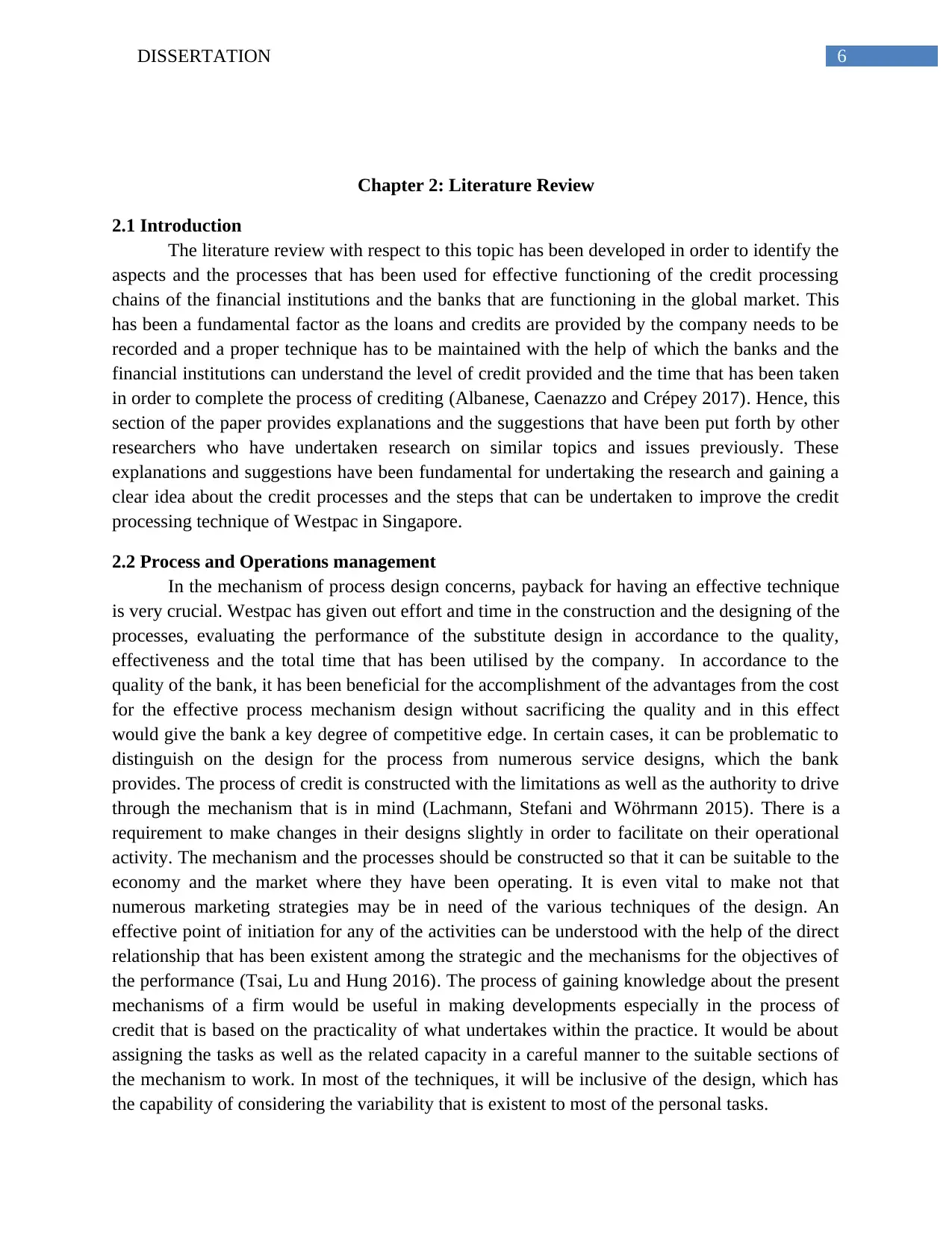
6DISSERTATION
Chapter 2: Literature Review
2.1 Introduction
The literature review with respect to this topic has been developed in order to identify the
aspects and the processes that has been used for effective functioning of the credit processing
chains of the financial institutions and the banks that are functioning in the global market. This
has been a fundamental factor as the loans and credits are provided by the company needs to be
recorded and a proper technique has to be maintained with the help of which the banks and the
financial institutions can understand the level of credit provided and the time that has been taken
in order to complete the process of crediting (Albanese, Caenazzo and Crépey 2017). Hence, this
section of the paper provides explanations and the suggestions that have been put forth by other
researchers who have undertaken research on similar topics and issues previously. These
explanations and suggestions have been fundamental for undertaking the research and gaining a
clear idea about the credit processes and the steps that can be undertaken to improve the credit
processing technique of Westpac in Singapore.
2.2 Process and Operations management
In the mechanism of process design concerns, payback for having an effective technique
is very crucial. Westpac has given out effort and time in the construction and the designing of the
processes, evaluating the performance of the substitute design in accordance to the quality,
effectiveness and the total time that has been utilised by the company. In accordance to the
quality of the bank, it has been beneficial for the accomplishment of the advantages from the cost
for the effective process mechanism design without sacrificing the quality and in this effect
would give the bank a key degree of competitive edge. In certain cases, it can be problematic to
distinguish on the design for the process from numerous service designs, which the bank
provides. The process of credit is constructed with the limitations as well as the authority to drive
through the mechanism that is in mind (Lachmann, Stefani and Wöhrmann 2015). There is a
requirement to make changes in their designs slightly in order to facilitate on their operational
activity. The mechanism and the processes should be constructed so that it can be suitable to the
economy and the market where they have been operating. It is even vital to make not that
numerous marketing strategies may be in need of the various techniques of the design. An
effective point of initiation for any of the activities can be understood with the help of the direct
relationship that has been existent among the strategic and the mechanisms for the objectives of
the performance (Tsai, Lu and Hung 2016). The process of gaining knowledge about the present
mechanisms of a firm would be useful in making developments especially in the process of
credit that is based on the practicality of what undertakes within the practice. It would be about
assigning the tasks as well as the related capacity in a careful manner to the suitable sections of
the mechanism to work. In most of the techniques, it will be inclusive of the design, which has
the capability of considering the variability that is existent to most of the personal tasks.
Chapter 2: Literature Review
2.1 Introduction
The literature review with respect to this topic has been developed in order to identify the
aspects and the processes that has been used for effective functioning of the credit processing
chains of the financial institutions and the banks that are functioning in the global market. This
has been a fundamental factor as the loans and credits are provided by the company needs to be
recorded and a proper technique has to be maintained with the help of which the banks and the
financial institutions can understand the level of credit provided and the time that has been taken
in order to complete the process of crediting (Albanese, Caenazzo and Crépey 2017). Hence, this
section of the paper provides explanations and the suggestions that have been put forth by other
researchers who have undertaken research on similar topics and issues previously. These
explanations and suggestions have been fundamental for undertaking the research and gaining a
clear idea about the credit processes and the steps that can be undertaken to improve the credit
processing technique of Westpac in Singapore.
2.2 Process and Operations management
In the mechanism of process design concerns, payback for having an effective technique
is very crucial. Westpac has given out effort and time in the construction and the designing of the
processes, evaluating the performance of the substitute design in accordance to the quality,
effectiveness and the total time that has been utilised by the company. In accordance to the
quality of the bank, it has been beneficial for the accomplishment of the advantages from the cost
for the effective process mechanism design without sacrificing the quality and in this effect
would give the bank a key degree of competitive edge. In certain cases, it can be problematic to
distinguish on the design for the process from numerous service designs, which the bank
provides. The process of credit is constructed with the limitations as well as the authority to drive
through the mechanism that is in mind (Lachmann, Stefani and Wöhrmann 2015). There is a
requirement to make changes in their designs slightly in order to facilitate on their operational
activity. The mechanism and the processes should be constructed so that it can be suitable to the
economy and the market where they have been operating. It is even vital to make not that
numerous marketing strategies may be in need of the various techniques of the design. An
effective point of initiation for any of the activities can be understood with the help of the direct
relationship that has been existent among the strategic and the mechanisms for the objectives of
the performance (Tsai, Lu and Hung 2016). The process of gaining knowledge about the present
mechanisms of a firm would be useful in making developments especially in the process of
credit that is based on the practicality of what undertakes within the practice. It would be about
assigning the tasks as well as the related capacity in a careful manner to the suitable sections of
the mechanism to work. In most of the techniques, it will be inclusive of the design, which has
the capability of considering the variability that is existent to most of the personal tasks.
Paraphrase This Document
Need a fresh take? Get an instant paraphrase of this document with our AI Paraphraser
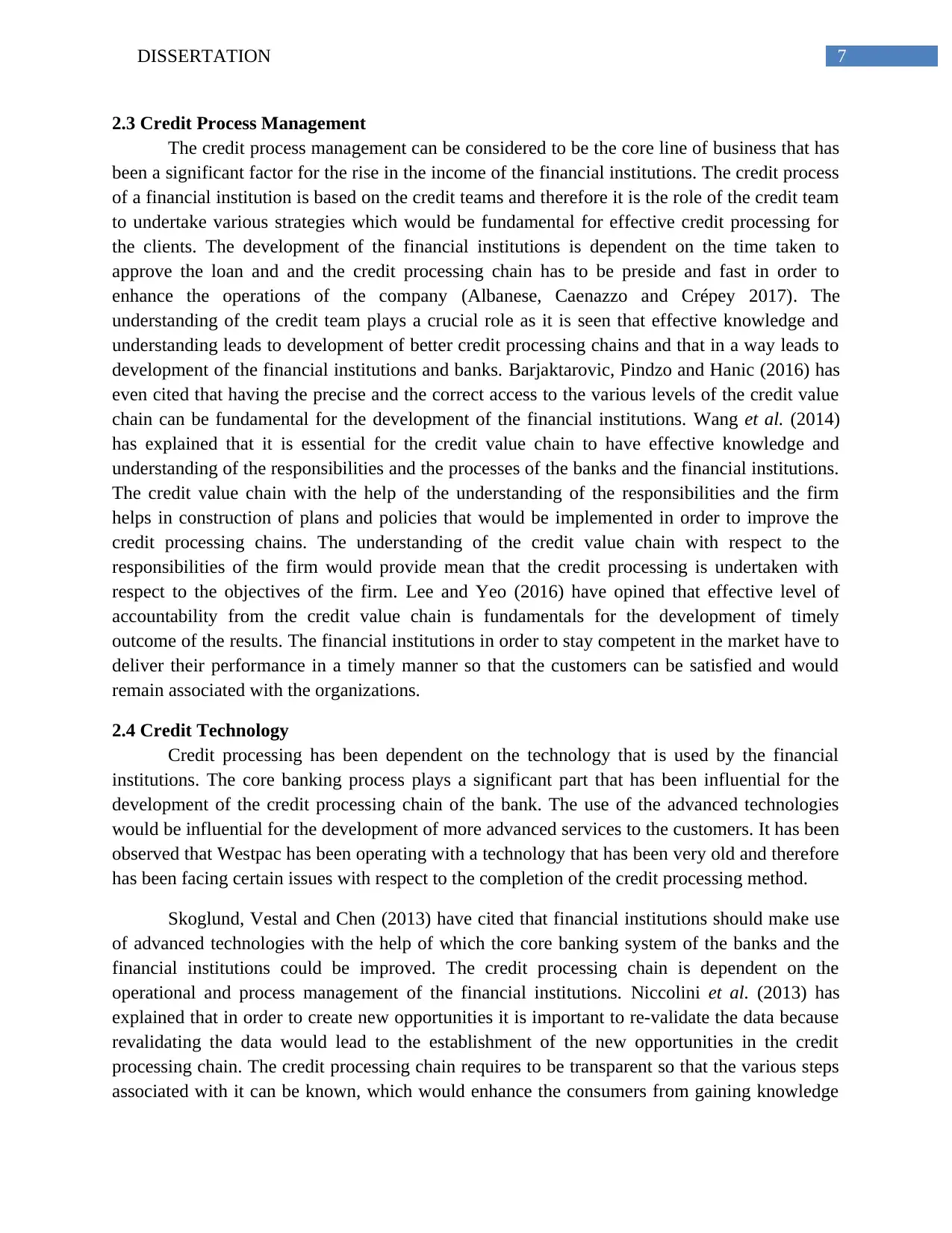
7DISSERTATION
2.3 Credit Process Management
The credit process management can be considered to be the core line of business that has
been a significant factor for the rise in the income of the financial institutions. The credit process
of a financial institution is based on the credit teams and therefore it is the role of the credit team
to undertake various strategies which would be fundamental for effective credit processing for
the clients. The development of the financial institutions is dependent on the time taken to
approve the loan and and the credit processing chain has to be preside and fast in order to
enhance the operations of the company (Albanese, Caenazzo and Crépey 2017). The
understanding of the credit team plays a crucial role as it is seen that effective knowledge and
understanding leads to development of better credit processing chains and that in a way leads to
development of the financial institutions and banks. Barjaktarovic, Pindzo and Hanic (2016) has
even cited that having the precise and the correct access to the various levels of the credit value
chain can be fundamental for the development of the financial institutions. Wang et al. (2014)
has explained that it is essential for the credit value chain to have effective knowledge and
understanding of the responsibilities and the processes of the banks and the financial institutions.
The credit value chain with the help of the understanding of the responsibilities and the firm
helps in construction of plans and policies that would be implemented in order to improve the
credit processing chains. The understanding of the credit value chain with respect to the
responsibilities of the firm would provide mean that the credit processing is undertaken with
respect to the objectives of the firm. Lee and Yeo (2016) have opined that effective level of
accountability from the credit value chain is fundamentals for the development of timely
outcome of the results. The financial institutions in order to stay competent in the market have to
deliver their performance in a timely manner so that the customers can be satisfied and would
remain associated with the organizations.
2.4 Credit Technology
Credit processing has been dependent on the technology that is used by the financial
institutions. The core banking process plays a significant part that has been influential for the
development of the credit processing chain of the bank. The use of the advanced technologies
would be influential for the development of more advanced services to the customers. It has been
observed that Westpac has been operating with a technology that has been very old and therefore
has been facing certain issues with respect to the completion of the credit processing method.
Skoglund, Vestal and Chen (2013) have cited that financial institutions should make use
of advanced technologies with the help of which the core banking system of the banks and the
financial institutions could be improved. The credit processing chain is dependent on the
operational and process management of the financial institutions. Niccolini et al. (2013) has
explained that in order to create new opportunities it is important to re-validate the data because
revalidating the data would lead to the establishment of the new opportunities in the credit
processing chain. The credit processing chain requires to be transparent so that the various steps
associated with it can be known, which would enhance the consumers from gaining knowledge
2.3 Credit Process Management
The credit process management can be considered to be the core line of business that has
been a significant factor for the rise in the income of the financial institutions. The credit process
of a financial institution is based on the credit teams and therefore it is the role of the credit team
to undertake various strategies which would be fundamental for effective credit processing for
the clients. The development of the financial institutions is dependent on the time taken to
approve the loan and and the credit processing chain has to be preside and fast in order to
enhance the operations of the company (Albanese, Caenazzo and Crépey 2017). The
understanding of the credit team plays a crucial role as it is seen that effective knowledge and
understanding leads to development of better credit processing chains and that in a way leads to
development of the financial institutions and banks. Barjaktarovic, Pindzo and Hanic (2016) has
even cited that having the precise and the correct access to the various levels of the credit value
chain can be fundamental for the development of the financial institutions. Wang et al. (2014)
has explained that it is essential for the credit value chain to have effective knowledge and
understanding of the responsibilities and the processes of the banks and the financial institutions.
The credit value chain with the help of the understanding of the responsibilities and the firm
helps in construction of plans and policies that would be implemented in order to improve the
credit processing chains. The understanding of the credit value chain with respect to the
responsibilities of the firm would provide mean that the credit processing is undertaken with
respect to the objectives of the firm. Lee and Yeo (2016) have opined that effective level of
accountability from the credit value chain is fundamentals for the development of timely
outcome of the results. The financial institutions in order to stay competent in the market have to
deliver their performance in a timely manner so that the customers can be satisfied and would
remain associated with the organizations.
2.4 Credit Technology
Credit processing has been dependent on the technology that is used by the financial
institutions. The core banking process plays a significant part that has been influential for the
development of the credit processing chain of the bank. The use of the advanced technologies
would be influential for the development of more advanced services to the customers. It has been
observed that Westpac has been operating with a technology that has been very old and therefore
has been facing certain issues with respect to the completion of the credit processing method.
Skoglund, Vestal and Chen (2013) have cited that financial institutions should make use
of advanced technologies with the help of which the core banking system of the banks and the
financial institutions could be improved. The credit processing chain is dependent on the
operational and process management of the financial institutions. Niccolini et al. (2013) has
explained that in order to create new opportunities it is important to re-validate the data because
revalidating the data would lead to the establishment of the new opportunities in the credit
processing chain. The credit processing chain requires to be transparent so that the various steps
associated with it can be known, which would enhance the consumers from gaining knowledge
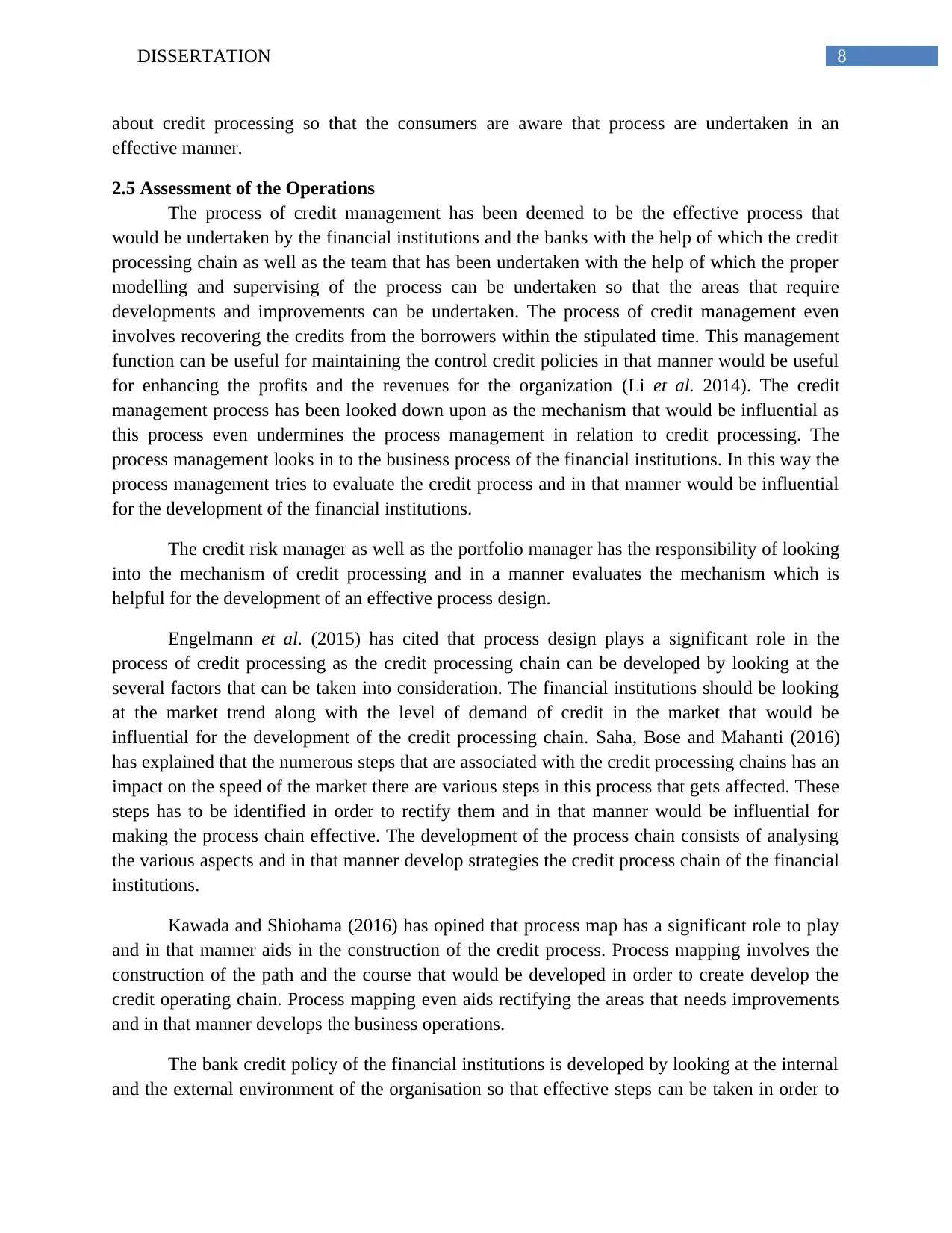
8DISSERTATION
about credit processing so that the consumers are aware that process are undertaken in an
effective manner.
2.5 Assessment of the Operations
The process of credit management has been deemed to be the effective process that
would be undertaken by the financial institutions and the banks with the help of which the credit
processing chain as well as the team that has been undertaken with the help of which the proper
modelling and supervising of the process can be undertaken so that the areas that require
developments and improvements can be undertaken. The process of credit management even
involves recovering the credits from the borrowers within the stipulated time. This management
function can be useful for maintaining the control credit policies in that manner would be useful
for enhancing the profits and the revenues for the organization (Li et al. 2014). The credit
management process has been looked down upon as the mechanism that would be influential as
this process even undermines the process management in relation to credit processing. The
process management looks in to the business process of the financial institutions. In this way the
process management tries to evaluate the credit process and in that manner would be influential
for the development of the financial institutions.
The credit risk manager as well as the portfolio manager has the responsibility of looking
into the mechanism of credit processing and in a manner evaluates the mechanism which is
helpful for the development of an effective process design.
Engelmann et al. (2015) has cited that process design plays a significant role in the
process of credit processing as the credit processing chain can be developed by looking at the
several factors that can be taken into consideration. The financial institutions should be looking
at the market trend along with the level of demand of credit in the market that would be
influential for the development of the credit processing chain. Saha, Bose and Mahanti (2016)
has explained that the numerous steps that are associated with the credit processing chains has an
impact on the speed of the market there are various steps in this process that gets affected. These
steps has to be identified in order to rectify them and in that manner would be influential for
making the process chain effective. The development of the process chain consists of analysing
the various aspects and in that manner develop strategies the credit process chain of the financial
institutions.
Kawada and Shiohama (2016) has opined that process map has a significant role to play
and in that manner aids in the construction of the credit process. Process mapping involves the
construction of the path and the course that would be developed in order to create develop the
credit operating chain. Process mapping even aids rectifying the areas that needs improvements
and in that manner develops the business operations.
The bank credit policy of the financial institutions is developed by looking at the internal
and the external environment of the organisation so that effective steps can be taken in order to
about credit processing so that the consumers are aware that process are undertaken in an
effective manner.
2.5 Assessment of the Operations
The process of credit management has been deemed to be the effective process that
would be undertaken by the financial institutions and the banks with the help of which the credit
processing chain as well as the team that has been undertaken with the help of which the proper
modelling and supervising of the process can be undertaken so that the areas that require
developments and improvements can be undertaken. The process of credit management even
involves recovering the credits from the borrowers within the stipulated time. This management
function can be useful for maintaining the control credit policies in that manner would be useful
for enhancing the profits and the revenues for the organization (Li et al. 2014). The credit
management process has been looked down upon as the mechanism that would be influential as
this process even undermines the process management in relation to credit processing. The
process management looks in to the business process of the financial institutions. In this way the
process management tries to evaluate the credit process and in that manner would be influential
for the development of the financial institutions.
The credit risk manager as well as the portfolio manager has the responsibility of looking
into the mechanism of credit processing and in a manner evaluates the mechanism which is
helpful for the development of an effective process design.
Engelmann et al. (2015) has cited that process design plays a significant role in the
process of credit processing as the credit processing chain can be developed by looking at the
several factors that can be taken into consideration. The financial institutions should be looking
at the market trend along with the level of demand of credit in the market that would be
influential for the development of the credit processing chain. Saha, Bose and Mahanti (2016)
has explained that the numerous steps that are associated with the credit processing chains has an
impact on the speed of the market there are various steps in this process that gets affected. These
steps has to be identified in order to rectify them and in that manner would be influential for
making the process chain effective. The development of the process chain consists of analysing
the various aspects and in that manner develop strategies the credit process chain of the financial
institutions.
Kawada and Shiohama (2016) has opined that process map has a significant role to play
and in that manner aids in the construction of the credit process. Process mapping involves the
construction of the path and the course that would be developed in order to create develop the
credit operating chain. Process mapping even aids rectifying the areas that needs improvements
and in that manner develops the business operations.
The bank credit policy of the financial institutions is developed by looking at the internal
and the external environment of the organisation so that effective steps can be taken in order to
You're viewing a preview
Unlock full access by subscribing today!
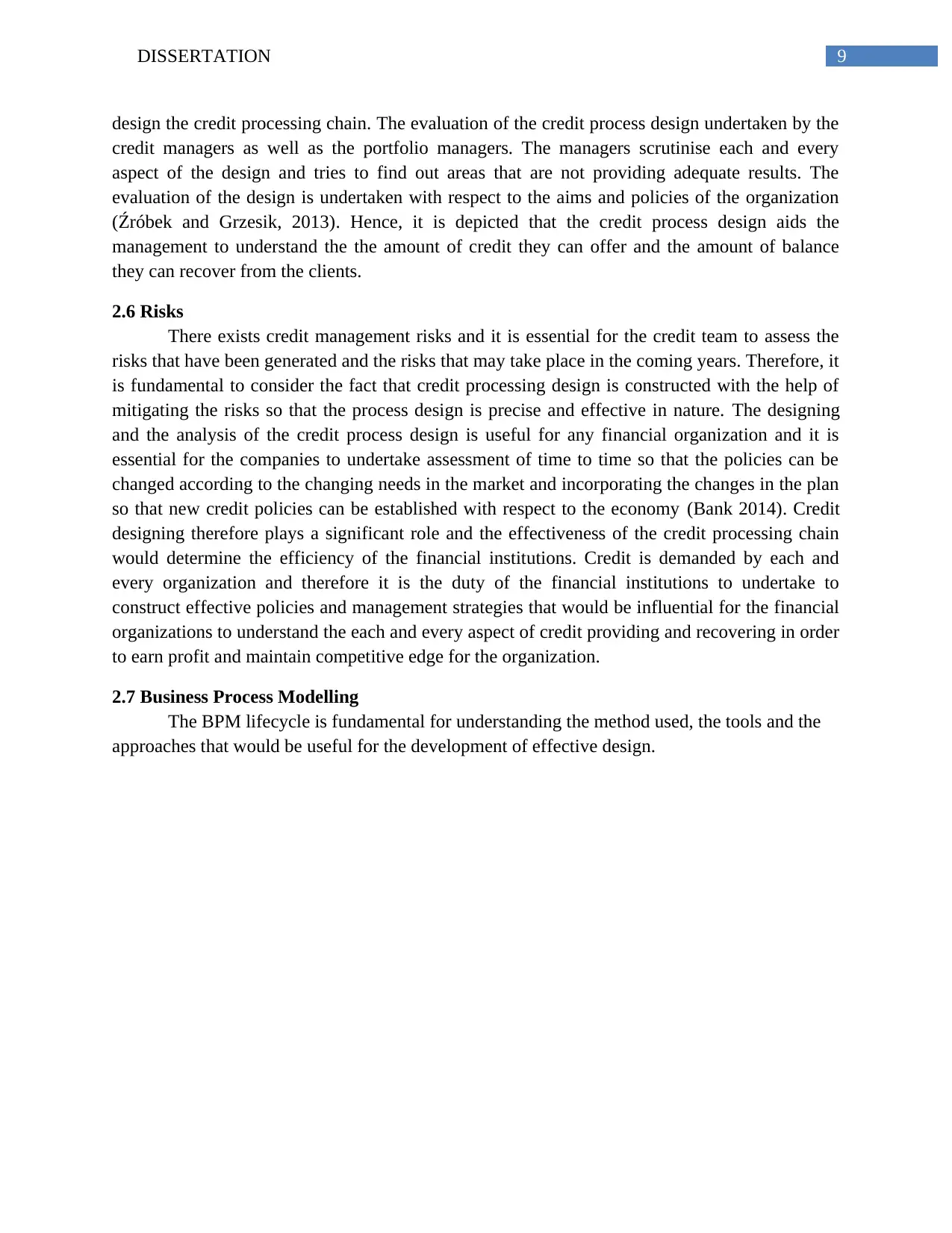
9DISSERTATION
design the credit processing chain. The evaluation of the credit process design undertaken by the
credit managers as well as the portfolio managers. The managers scrutinise each and every
aspect of the design and tries to find out areas that are not providing adequate results. The
evaluation of the design is undertaken with respect to the aims and policies of the organization
(Źróbek and Grzesik, 2013). Hence, it is depicted that the credit process design aids the
management to understand the the amount of credit they can offer and the amount of balance
they can recover from the clients.
2.6 Risks
There exists credit management risks and it is essential for the credit team to assess the
risks that have been generated and the risks that may take place in the coming years. Therefore, it
is fundamental to consider the fact that credit processing design is constructed with the help of
mitigating the risks so that the process design is precise and effective in nature. The designing
and the analysis of the credit process design is useful for any financial organization and it is
essential for the companies to undertake assessment of time to time so that the policies can be
changed according to the changing needs in the market and incorporating the changes in the plan
so that new credit policies can be established with respect to the economy (Bank 2014). Credit
designing therefore plays a significant role and the effectiveness of the credit processing chain
would determine the efficiency of the financial institutions. Credit is demanded by each and
every organization and therefore it is the duty of the financial institutions to undertake to
construct effective policies and management strategies that would be influential for the financial
organizations to understand the each and every aspect of credit providing and recovering in order
to earn profit and maintain competitive edge for the organization.
2.7 Business Process Modelling
The BPM lifecycle is fundamental for understanding the method used, the tools and the
approaches that would be useful for the development of effective design.
design the credit processing chain. The evaluation of the credit process design undertaken by the
credit managers as well as the portfolio managers. The managers scrutinise each and every
aspect of the design and tries to find out areas that are not providing adequate results. The
evaluation of the design is undertaken with respect to the aims and policies of the organization
(Źróbek and Grzesik, 2013). Hence, it is depicted that the credit process design aids the
management to understand the the amount of credit they can offer and the amount of balance
they can recover from the clients.
2.6 Risks
There exists credit management risks and it is essential for the credit team to assess the
risks that have been generated and the risks that may take place in the coming years. Therefore, it
is fundamental to consider the fact that credit processing design is constructed with the help of
mitigating the risks so that the process design is precise and effective in nature. The designing
and the analysis of the credit process design is useful for any financial organization and it is
essential for the companies to undertake assessment of time to time so that the policies can be
changed according to the changing needs in the market and incorporating the changes in the plan
so that new credit policies can be established with respect to the economy (Bank 2014). Credit
designing therefore plays a significant role and the effectiveness of the credit processing chain
would determine the efficiency of the financial institutions. Credit is demanded by each and
every organization and therefore it is the duty of the financial institutions to undertake to
construct effective policies and management strategies that would be influential for the financial
organizations to understand the each and every aspect of credit providing and recovering in order
to earn profit and maintain competitive edge for the organization.
2.7 Business Process Modelling
The BPM lifecycle is fundamental for understanding the method used, the tools and the
approaches that would be useful for the development of effective design.
Paraphrase This Document
Need a fresh take? Get an instant paraphrase of this document with our AI Paraphraser
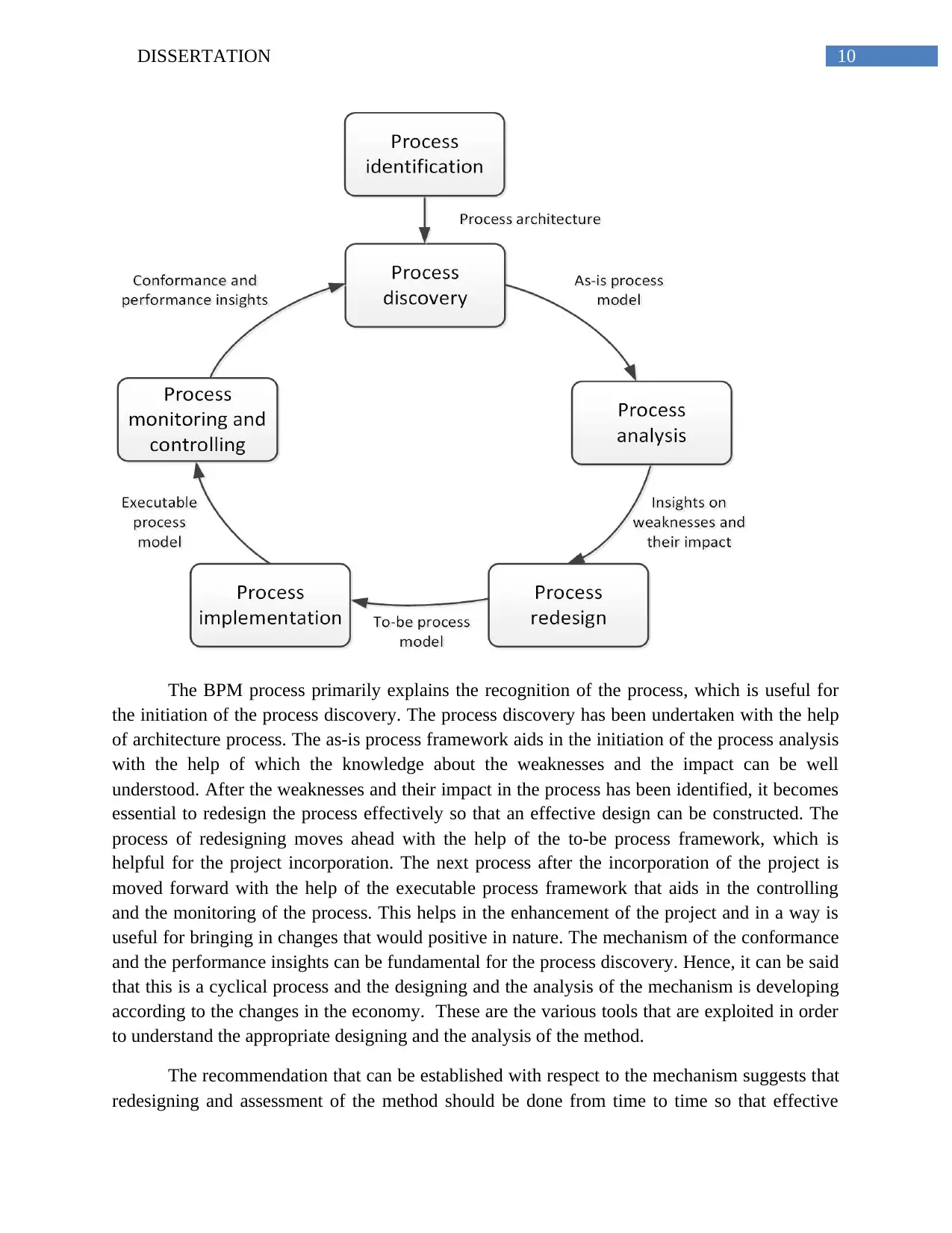
10DISSERTATION
The BPM process primarily explains the recognition of the process, which is useful for
the initiation of the process discovery. The process discovery has been undertaken with the help
of architecture process. The as-is process framework aids in the initiation of the process analysis
with the help of which the knowledge about the weaknesses and the impact can be well
understood. After the weaknesses and their impact in the process has been identified, it becomes
essential to redesign the process effectively so that an effective design can be constructed. The
process of redesigning moves ahead with the help of the to-be process framework, which is
helpful for the project incorporation. The next process after the incorporation of the project is
moved forward with the help of the executable process framework that aids in the controlling
and the monitoring of the process. This helps in the enhancement of the project and in a way is
useful for bringing in changes that would positive in nature. The mechanism of the conformance
and the performance insights can be fundamental for the process discovery. Hence, it can be said
that this is a cyclical process and the designing and the analysis of the mechanism is developing
according to the changes in the economy. These are the various tools that are exploited in order
to understand the appropriate designing and the analysis of the method.
The recommendation that can be established with respect to the mechanism suggests that
redesigning and assessment of the method should be done from time to time so that effective
The BPM process primarily explains the recognition of the process, which is useful for
the initiation of the process discovery. The process discovery has been undertaken with the help
of architecture process. The as-is process framework aids in the initiation of the process analysis
with the help of which the knowledge about the weaknesses and the impact can be well
understood. After the weaknesses and their impact in the process has been identified, it becomes
essential to redesign the process effectively so that an effective design can be constructed. The
process of redesigning moves ahead with the help of the to-be process framework, which is
helpful for the project incorporation. The next process after the incorporation of the project is
moved forward with the help of the executable process framework that aids in the controlling
and the monitoring of the process. This helps in the enhancement of the project and in a way is
useful for bringing in changes that would positive in nature. The mechanism of the conformance
and the performance insights can be fundamental for the process discovery. Hence, it can be said
that this is a cyclical process and the designing and the analysis of the mechanism is developing
according to the changes in the economy. These are the various tools that are exploited in order
to understand the appropriate designing and the analysis of the method.
The recommendation that can be established with respect to the mechanism suggests that
redesigning and assessment of the method should be done from time to time so that effective

11DISSERTATION
measures can be taken in order to keep the mechanism updated and in line with the market so
that the process of BPM lifecycle can be used effectively.
measures can be taken in order to keep the mechanism updated and in line with the market so
that the process of BPM lifecycle can be used effectively.
You're viewing a preview
Unlock full access by subscribing today!
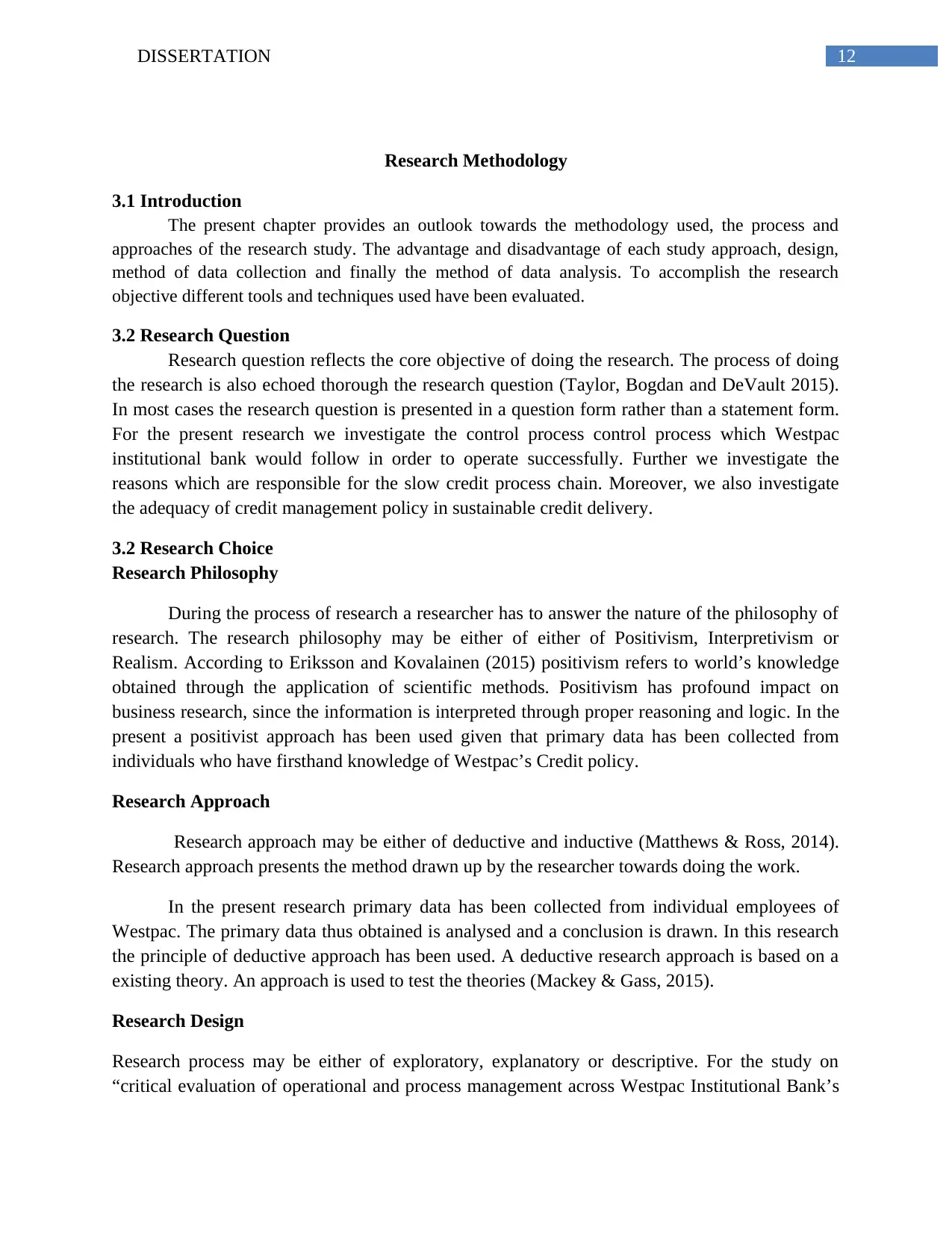
12DISSERTATION
Research Methodology
3.1 Introduction
The present chapter provides an outlook towards the methodology used, the process and
approaches of the research study. The advantage and disadvantage of each study approach, design,
method of data collection and finally the method of data analysis. To accomplish the research
objective different tools and techniques used have been evaluated.
3.2 Research Question
Research question reflects the core objective of doing the research. The process of doing
the research is also echoed thorough the research question (Taylor, Bogdan and DeVault 2015).
In most cases the research question is presented in a question form rather than a statement form.
For the present research we investigate the control process control process which Westpac
institutional bank would follow in order to operate successfully. Further we investigate the
reasons which are responsible for the slow credit process chain. Moreover, we also investigate
the adequacy of credit management policy in sustainable credit delivery.
3.2 Research Choice
Research Philosophy
During the process of research a researcher has to answer the nature of the philosophy of
research. The research philosophy may be either of either of Positivism, Interpretivism or
Realism. According to Eriksson and Kovalainen (2015) positivism refers to world’s knowledge
obtained through the application of scientific methods. Positivism has profound impact on
business research, since the information is interpreted through proper reasoning and logic. In the
present a positivist approach has been used given that primary data has been collected from
individuals who have firsthand knowledge of Westpac’s Credit policy.
Research Approach
Research approach may be either of deductive and inductive (Matthews & Ross, 2014).
Research approach presents the method drawn up by the researcher towards doing the work.
In the present research primary data has been collected from individual employees of
Westpac. The primary data thus obtained is analysed and a conclusion is drawn. In this research
the principle of deductive approach has been used. A deductive research approach is based on a
existing theory. An approach is used to test the theories (Mackey & Gass, 2015).
Research Design
Research process may be either of exploratory, explanatory or descriptive. For the study on
“critical evaluation of operational and process management across Westpac Institutional Bank’s
Research Methodology
3.1 Introduction
The present chapter provides an outlook towards the methodology used, the process and
approaches of the research study. The advantage and disadvantage of each study approach, design,
method of data collection and finally the method of data analysis. To accomplish the research
objective different tools and techniques used have been evaluated.
3.2 Research Question
Research question reflects the core objective of doing the research. The process of doing
the research is also echoed thorough the research question (Taylor, Bogdan and DeVault 2015).
In most cases the research question is presented in a question form rather than a statement form.
For the present research we investigate the control process control process which Westpac
institutional bank would follow in order to operate successfully. Further we investigate the
reasons which are responsible for the slow credit process chain. Moreover, we also investigate
the adequacy of credit management policy in sustainable credit delivery.
3.2 Research Choice
Research Philosophy
During the process of research a researcher has to answer the nature of the philosophy of
research. The research philosophy may be either of either of Positivism, Interpretivism or
Realism. According to Eriksson and Kovalainen (2015) positivism refers to world’s knowledge
obtained through the application of scientific methods. Positivism has profound impact on
business research, since the information is interpreted through proper reasoning and logic. In the
present a positivist approach has been used given that primary data has been collected from
individuals who have firsthand knowledge of Westpac’s Credit policy.
Research Approach
Research approach may be either of deductive and inductive (Matthews & Ross, 2014).
Research approach presents the method drawn up by the researcher towards doing the work.
In the present research primary data has been collected from individual employees of
Westpac. The primary data thus obtained is analysed and a conclusion is drawn. In this research
the principle of deductive approach has been used. A deductive research approach is based on a
existing theory. An approach is used to test the theories (Mackey & Gass, 2015).
Research Design
Research process may be either of exploratory, explanatory or descriptive. For the study on
“critical evaluation of operational and process management across Westpac Institutional Bank’s
Paraphrase This Document
Need a fresh take? Get an instant paraphrase of this document with our AI Paraphraser
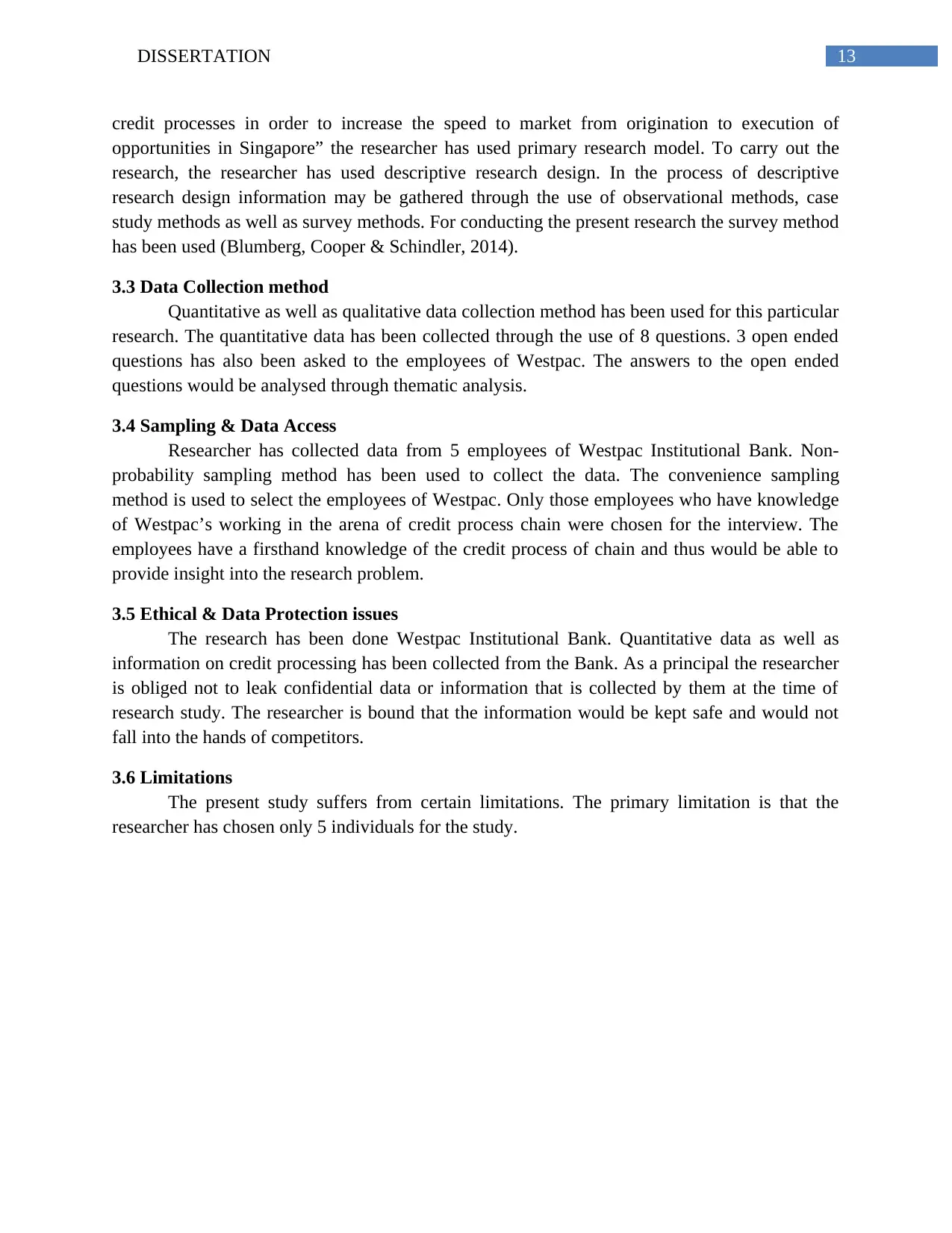
13DISSERTATION
credit processes in order to increase the speed to market from origination to execution of
opportunities in Singapore” the researcher has used primary research model. To carry out the
research, the researcher has used descriptive research design. In the process of descriptive
research design information may be gathered through the use of observational methods, case
study methods as well as survey methods. For conducting the present research the survey method
has been used (Blumberg, Cooper & Schindler, 2014).
3.3 Data Collection method
Quantitative as well as qualitative data collection method has been used for this particular
research. The quantitative data has been collected through the use of 8 questions. 3 open ended
questions has also been asked to the employees of Westpac. The answers to the open ended
questions would be analysed through thematic analysis.
3.4 Sampling & Data Access
Researcher has collected data from 5 employees of Westpac Institutional Bank. Non-
probability sampling method has been used to collect the data. The convenience sampling
method is used to select the employees of Westpac. Only those employees who have knowledge
of Westpac’s working in the arena of credit process chain were chosen for the interview. The
employees have a firsthand knowledge of the credit process of chain and thus would be able to
provide insight into the research problem.
3.5 Ethical & Data Protection issues
The research has been done Westpac Institutional Bank. Quantitative data as well as
information on credit processing has been collected from the Bank. As a principal the researcher
is obliged not to leak confidential data or information that is collected by them at the time of
research study. The researcher is bound that the information would be kept safe and would not
fall into the hands of competitors.
3.6 Limitations
The present study suffers from certain limitations. The primary limitation is that the
researcher has chosen only 5 individuals for the study.
credit processes in order to increase the speed to market from origination to execution of
opportunities in Singapore” the researcher has used primary research model. To carry out the
research, the researcher has used descriptive research design. In the process of descriptive
research design information may be gathered through the use of observational methods, case
study methods as well as survey methods. For conducting the present research the survey method
has been used (Blumberg, Cooper & Schindler, 2014).
3.3 Data Collection method
Quantitative as well as qualitative data collection method has been used for this particular
research. The quantitative data has been collected through the use of 8 questions. 3 open ended
questions has also been asked to the employees of Westpac. The answers to the open ended
questions would be analysed through thematic analysis.
3.4 Sampling & Data Access
Researcher has collected data from 5 employees of Westpac Institutional Bank. Non-
probability sampling method has been used to collect the data. The convenience sampling
method is used to select the employees of Westpac. Only those employees who have knowledge
of Westpac’s working in the arena of credit process chain were chosen for the interview. The
employees have a firsthand knowledge of the credit process of chain and thus would be able to
provide insight into the research problem.
3.5 Ethical & Data Protection issues
The research has been done Westpac Institutional Bank. Quantitative data as well as
information on credit processing has been collected from the Bank. As a principal the researcher
is obliged not to leak confidential data or information that is collected by them at the time of
research study. The researcher is bound that the information would be kept safe and would not
fall into the hands of competitors.
3.6 Limitations
The present study suffers from certain limitations. The primary limitation is that the
researcher has chosen only 5 individuals for the study.
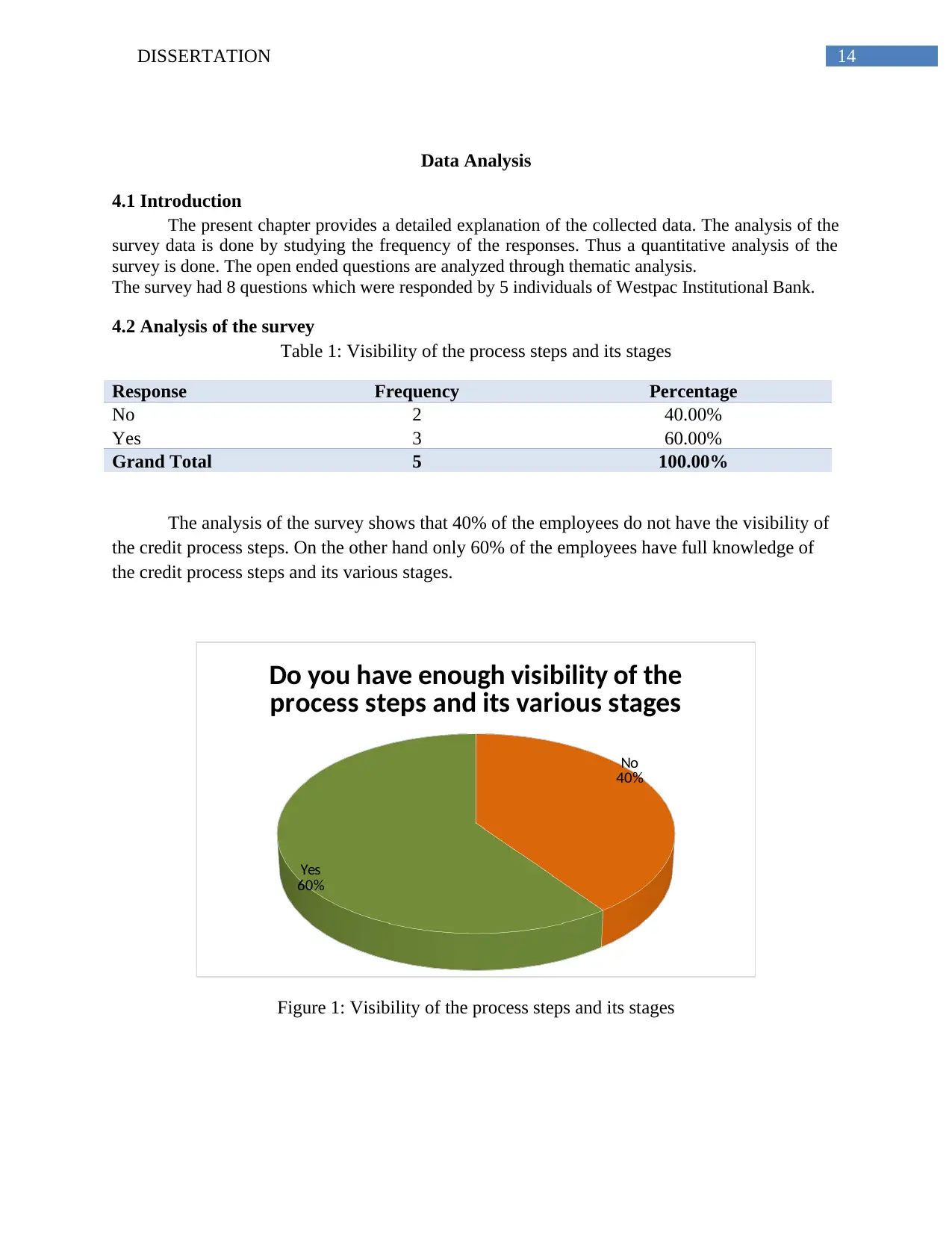
14DISSERTATION
Data Analysis
4.1 Introduction
The present chapter provides a detailed explanation of the collected data. The analysis of the
survey data is done by studying the frequency of the responses. Thus a quantitative analysis of the
survey is done. The open ended questions are analyzed through thematic analysis.
The survey had 8 questions which were responded by 5 individuals of Westpac Institutional Bank.
4.2 Analysis of the survey
Table 1: Visibility of the process steps and its stages
Response Frequency Percentage
No 2 40.00%
Yes 3 60.00%
Grand Total 5 100.00%
The analysis of the survey shows that 40% of the employees do not have the visibility of
the credit process steps. On the other hand only 60% of the employees have full knowledge of
the credit process steps and its various stages.
No
40%
Yes
60%
Do you have enough visibility of the
process steps and its various stages
Figure 1: Visibility of the process steps and its stages
Data Analysis
4.1 Introduction
The present chapter provides a detailed explanation of the collected data. The analysis of the
survey data is done by studying the frequency of the responses. Thus a quantitative analysis of the
survey is done. The open ended questions are analyzed through thematic analysis.
The survey had 8 questions which were responded by 5 individuals of Westpac Institutional Bank.
4.2 Analysis of the survey
Table 1: Visibility of the process steps and its stages
Response Frequency Percentage
No 2 40.00%
Yes 3 60.00%
Grand Total 5 100.00%
The analysis of the survey shows that 40% of the employees do not have the visibility of
the credit process steps. On the other hand only 60% of the employees have full knowledge of
the credit process steps and its various stages.
No
40%
Yes
60%
Do you have enough visibility of the
process steps and its various stages
Figure 1: Visibility of the process steps and its stages
You're viewing a preview
Unlock full access by subscribing today!
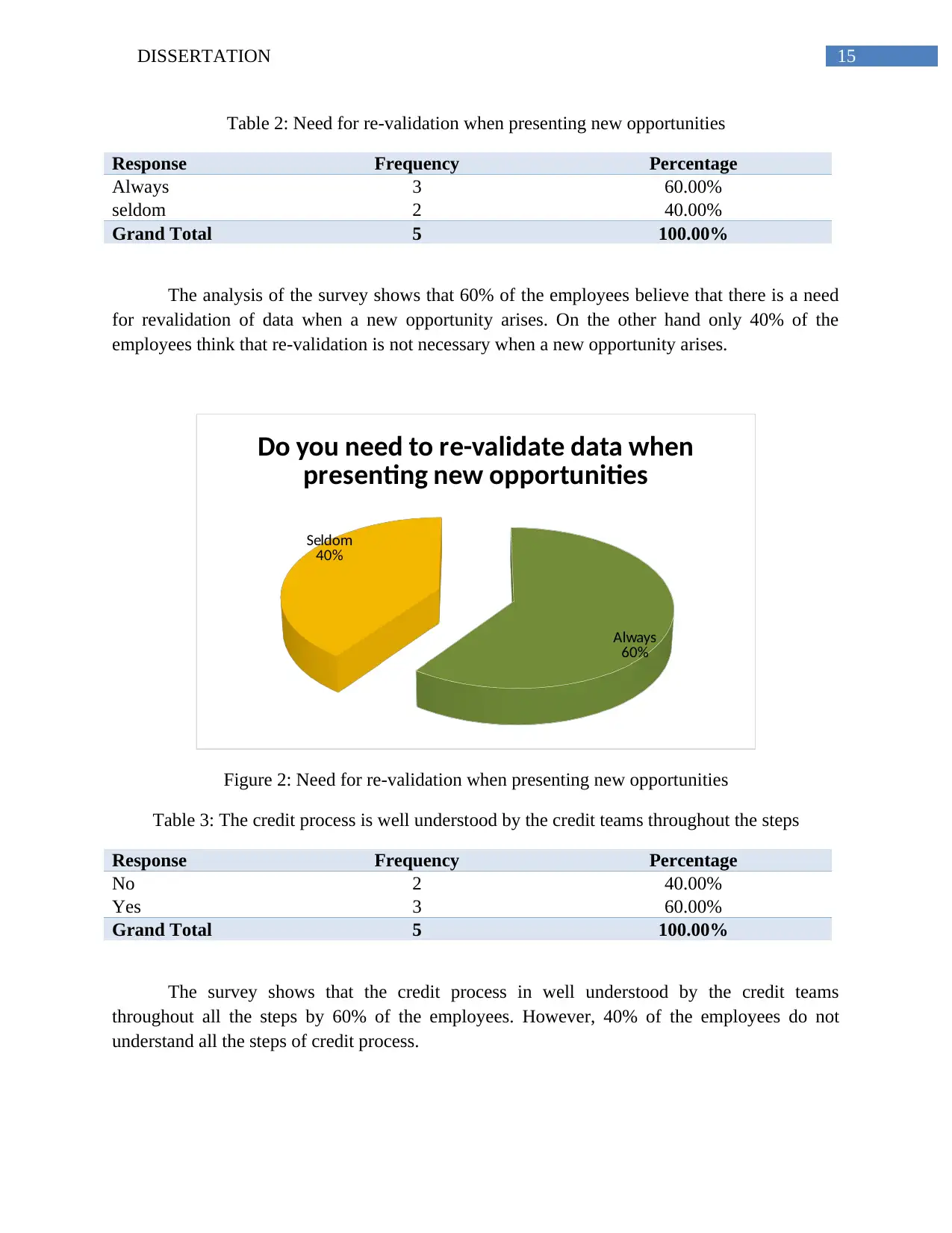
15DISSERTATION
Table 2: Need for re-validation when presenting new opportunities
Response Frequency Percentage
Always 3 60.00%
seldom 2 40.00%
Grand Total 5 100.00%
The analysis of the survey shows that 60% of the employees believe that there is a need
for revalidation of data when a new opportunity arises. On the other hand only 40% of the
employees think that re-validation is not necessary when a new opportunity arises.
Always
60%
Seldom
40%
Do you need to re-validate data when
presenting new opportunities
Figure 2: Need for re-validation when presenting new opportunities
Table 3: The credit process is well understood by the credit teams throughout the steps
Response Frequency Percentage
No 2 40.00%
Yes 3 60.00%
Grand Total 5 100.00%
The survey shows that the credit process in well understood by the credit teams
throughout all the steps by 60% of the employees. However, 40% of the employees do not
understand all the steps of credit process.
Table 2: Need for re-validation when presenting new opportunities
Response Frequency Percentage
Always 3 60.00%
seldom 2 40.00%
Grand Total 5 100.00%
The analysis of the survey shows that 60% of the employees believe that there is a need
for revalidation of data when a new opportunity arises. On the other hand only 40% of the
employees think that re-validation is not necessary when a new opportunity arises.
Always
60%
Seldom
40%
Do you need to re-validate data when
presenting new opportunities
Figure 2: Need for re-validation when presenting new opportunities
Table 3: The credit process is well understood by the credit teams throughout the steps
Response Frequency Percentage
No 2 40.00%
Yes 3 60.00%
Grand Total 5 100.00%
The survey shows that the credit process in well understood by the credit teams
throughout all the steps by 60% of the employees. However, 40% of the employees do not
understand all the steps of credit process.
Paraphrase This Document
Need a fresh take? Get an instant paraphrase of this document with our AI Paraphraser
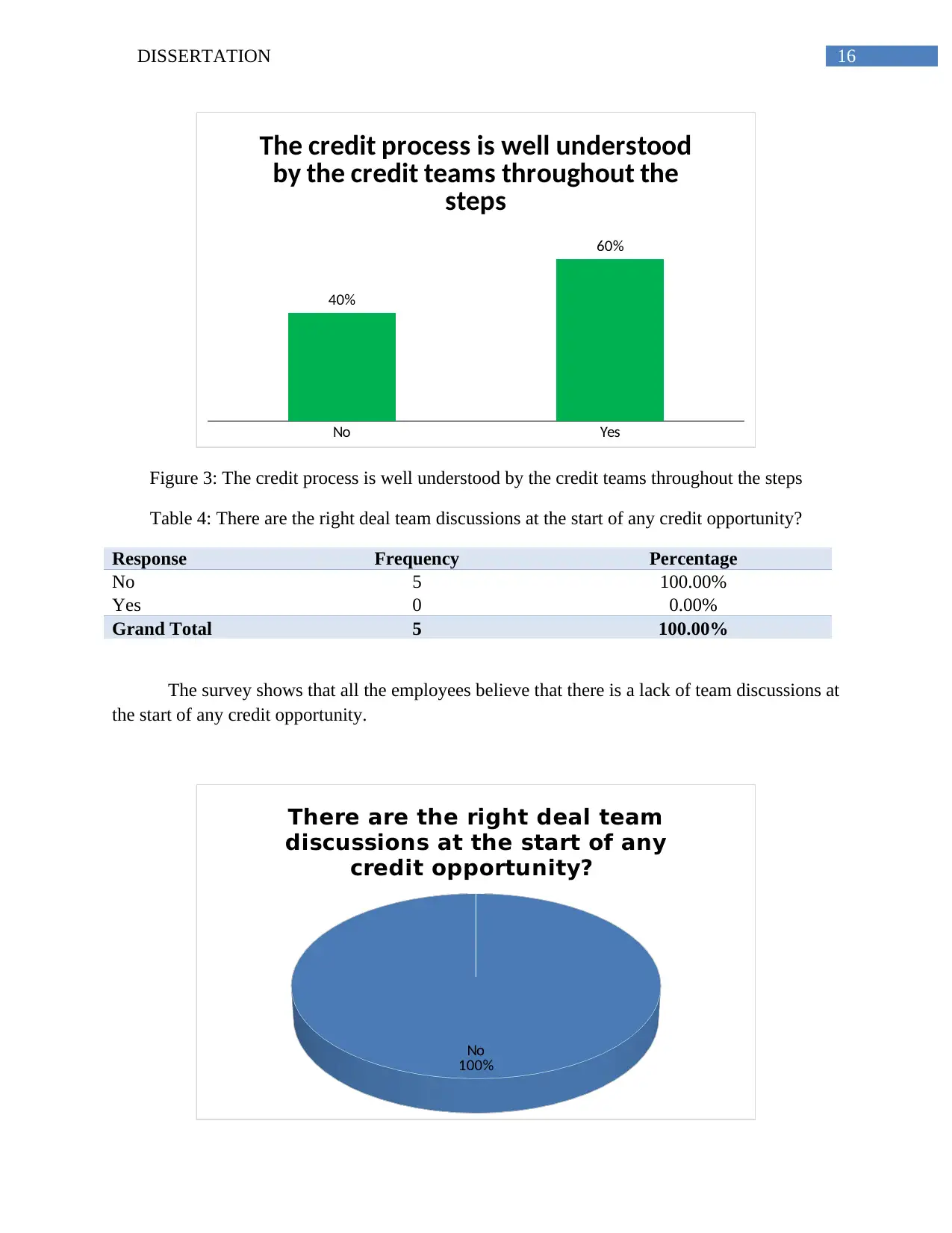
16DISSERTATION
No Yes
40%
60%
The credit process is well understood
by the credit teams throughout the
steps
Figure 3: The credit process is well understood by the credit teams throughout the steps
Table 4: There are the right deal team discussions at the start of any credit opportunity?
Response Frequency Percentage
No 5 100.00%
Yes 0 0.00%
Grand Total 5 100.00%
The survey shows that all the employees believe that there is a lack of team discussions at
the start of any credit opportunity.
No
100%
There are the right deal team
discussions at the start of any
credit opportunity?
No Yes
40%
60%
The credit process is well understood
by the credit teams throughout the
steps
Figure 3: The credit process is well understood by the credit teams throughout the steps
Table 4: There are the right deal team discussions at the start of any credit opportunity?
Response Frequency Percentage
No 5 100.00%
Yes 0 0.00%
Grand Total 5 100.00%
The survey shows that all the employees believe that there is a lack of team discussions at
the start of any credit opportunity.
No
100%
There are the right deal team
discussions at the start of any
credit opportunity?
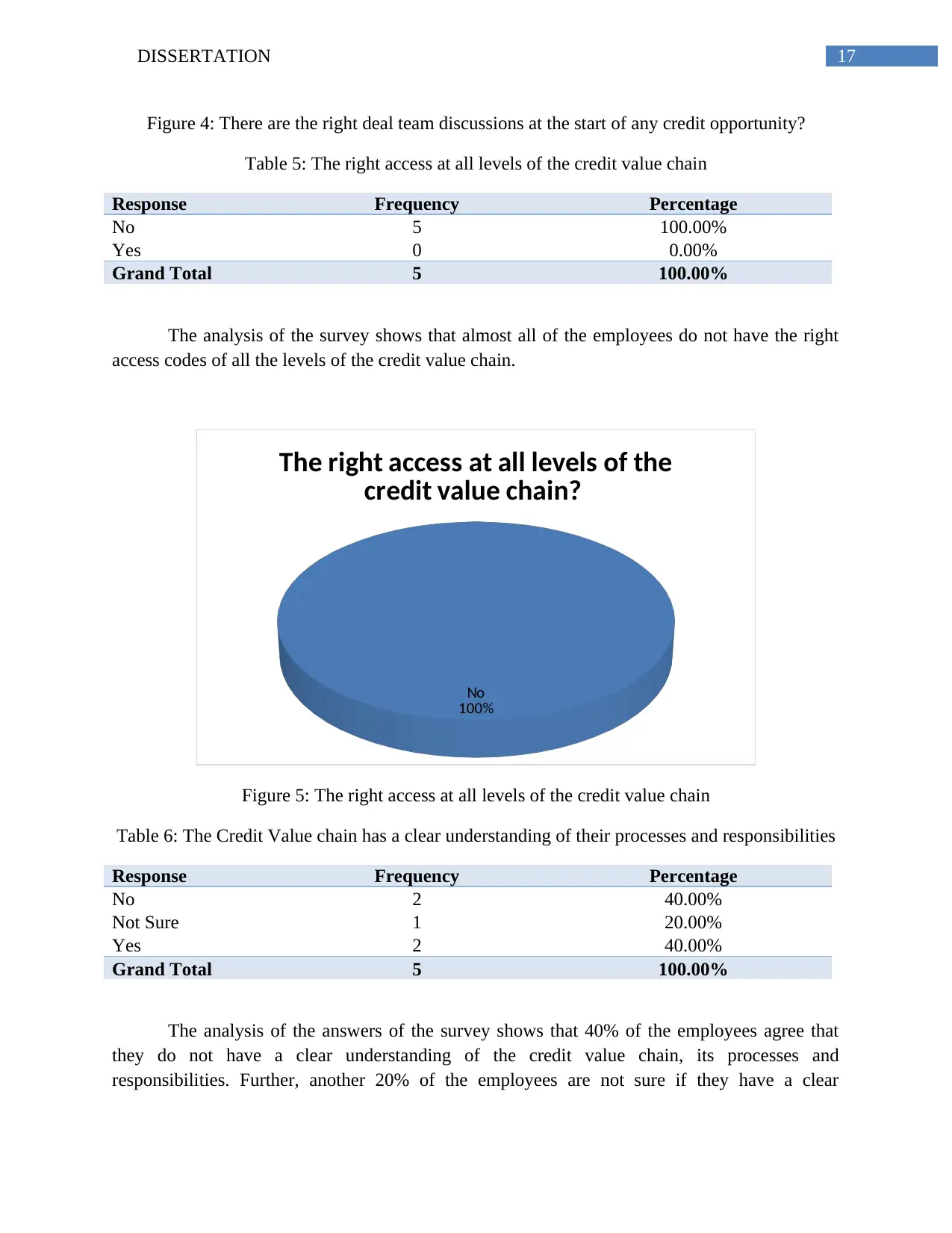
17DISSERTATION
Figure 4: There are the right deal team discussions at the start of any credit opportunity?
Table 5: The right access at all levels of the credit value chain
Response Frequency Percentage
No 5 100.00%
Yes 0 0.00%
Grand Total 5 100.00%
The analysis of the survey shows that almost all of the employees do not have the right
access codes of all the levels of the credit value chain.
No
100%
The right access at all levels of the
credit value chain?
Figure 5: The right access at all levels of the credit value chain
Table 6: The Credit Value chain has a clear understanding of their processes and responsibilities
Response Frequency Percentage
No 2 40.00%
Not Sure 1 20.00%
Yes 2 40.00%
Grand Total 5 100.00%
The analysis of the answers of the survey shows that 40% of the employees agree that
they do not have a clear understanding of the credit value chain, its processes and
responsibilities. Further, another 20% of the employees are not sure if they have a clear
Figure 4: There are the right deal team discussions at the start of any credit opportunity?
Table 5: The right access at all levels of the credit value chain
Response Frequency Percentage
No 5 100.00%
Yes 0 0.00%
Grand Total 5 100.00%
The analysis of the survey shows that almost all of the employees do not have the right
access codes of all the levels of the credit value chain.
No
100%
The right access at all levels of the
credit value chain?
Figure 5: The right access at all levels of the credit value chain
Table 6: The Credit Value chain has a clear understanding of their processes and responsibilities
Response Frequency Percentage
No 2 40.00%
Not Sure 1 20.00%
Yes 2 40.00%
Grand Total 5 100.00%
The analysis of the answers of the survey shows that 40% of the employees agree that
they do not have a clear understanding of the credit value chain, its processes and
responsibilities. Further, another 20% of the employees are not sure if they have a clear
You're viewing a preview
Unlock full access by subscribing today!
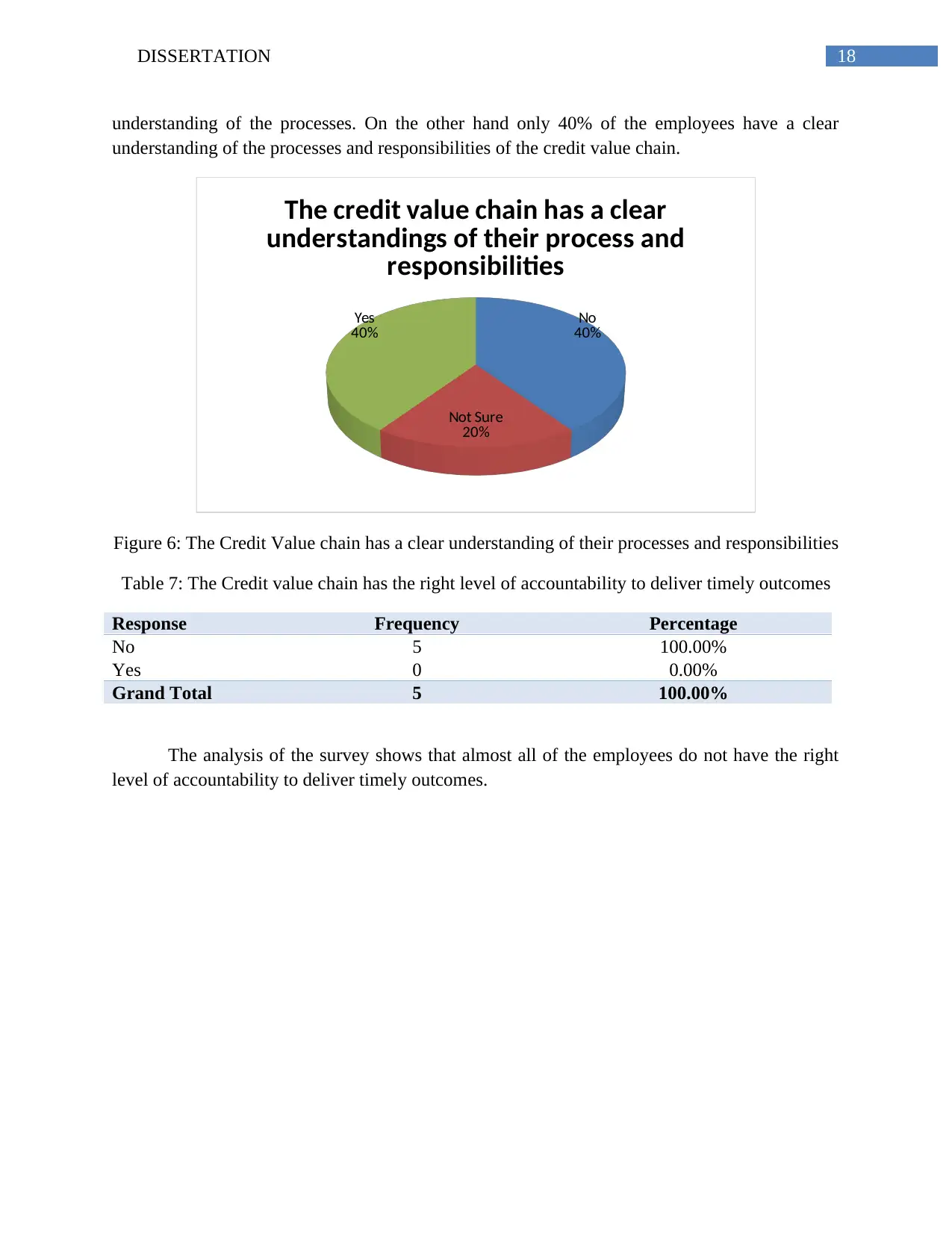
18DISSERTATION
understanding of the processes. On the other hand only 40% of the employees have a clear
understanding of the processes and responsibilities of the credit value chain.
No
40%
Not Sure
20%
Yes
40%
The credit value chain has a clear
understandings of their process and
responsibilities
Figure 6: The Credit Value chain has a clear understanding of their processes and responsibilities
Table 7: The Credit value chain has the right level of accountability to deliver timely outcomes
Response Frequency Percentage
No 5 100.00%
Yes 0 0.00%
Grand Total 5 100.00%
The analysis of the survey shows that almost all of the employees do not have the right
level of accountability to deliver timely outcomes.
understanding of the processes. On the other hand only 40% of the employees have a clear
understanding of the processes and responsibilities of the credit value chain.
No
40%
Not Sure
20%
Yes
40%
The credit value chain has a clear
understandings of their process and
responsibilities
Figure 6: The Credit Value chain has a clear understanding of their processes and responsibilities
Table 7: The Credit value chain has the right level of accountability to deliver timely outcomes
Response Frequency Percentage
No 5 100.00%
Yes 0 0.00%
Grand Total 5 100.00%
The analysis of the survey shows that almost all of the employees do not have the right
level of accountability to deliver timely outcomes.
Paraphrase This Document
Need a fresh take? Get an instant paraphrase of this document with our AI Paraphraser

19DISSERTATION
No
100%
The credit value chain has the right
level of accountability to deliver
timely outcomes
Figure 7: The Credit value chain has the right level of accountability to deliver timely outcomes
4.3 Analysis of Interview
The interview process of the Employees involved asking 4 questions. The results and
analysis of the interview is presented below.
4.3.1 Undesirable outcome
In response, the director, Commodity Sales said that Westpac provides credits with an
outlook towards Australia. He provided an example of how a steel mill was denied credit since
the prices of iron ore were low.
The Associate, Corporate Sales Asia made available the process of approval. He also
pointed out that how this process is unnecessarily time taking, long and tedious. He has a
personal experience of looking into a process which took more than 4 months.
The Associate Director provided an example where the client provided comments within
3 days, however Westpac took 2 weeks to respond. He added that the delay by the bank was of
no benefit to the client.
The Director of Corporate sales provided the example of an Agricultural client of
Westpac. He highlighted the fact that how during the credit preparation stage the portfolio
manager asked questions which should have been asked during the data collection stage. In his
opinion this meant that valuable time was lost.
In response to the above query the Head of Asian Rates and FA Trading stated that the
“credit process is geography specific.” This has involved the front office more than the fact it
should be involved in following the guidelines. A process thus now takes “12 months” to be
completed.
No
100%
The credit value chain has the right
level of accountability to deliver
timely outcomes
Figure 7: The Credit value chain has the right level of accountability to deliver timely outcomes
4.3 Analysis of Interview
The interview process of the Employees involved asking 4 questions. The results and
analysis of the interview is presented below.
4.3.1 Undesirable outcome
In response, the director, Commodity Sales said that Westpac provides credits with an
outlook towards Australia. He provided an example of how a steel mill was denied credit since
the prices of iron ore were low.
The Associate, Corporate Sales Asia made available the process of approval. He also
pointed out that how this process is unnecessarily time taking, long and tedious. He has a
personal experience of looking into a process which took more than 4 months.
The Associate Director provided an example where the client provided comments within
3 days, however Westpac took 2 weeks to respond. He added that the delay by the bank was of
no benefit to the client.
The Director of Corporate sales provided the example of an Agricultural client of
Westpac. He highlighted the fact that how during the credit preparation stage the portfolio
manager asked questions which should have been asked during the data collection stage. In his
opinion this meant that valuable time was lost.
In response to the above query the Head of Asian Rates and FA Trading stated that the
“credit process is geography specific.” This has involved the front office more than the fact it
should be involved in following the guidelines. A process thus now takes “12 months” to be
completed.
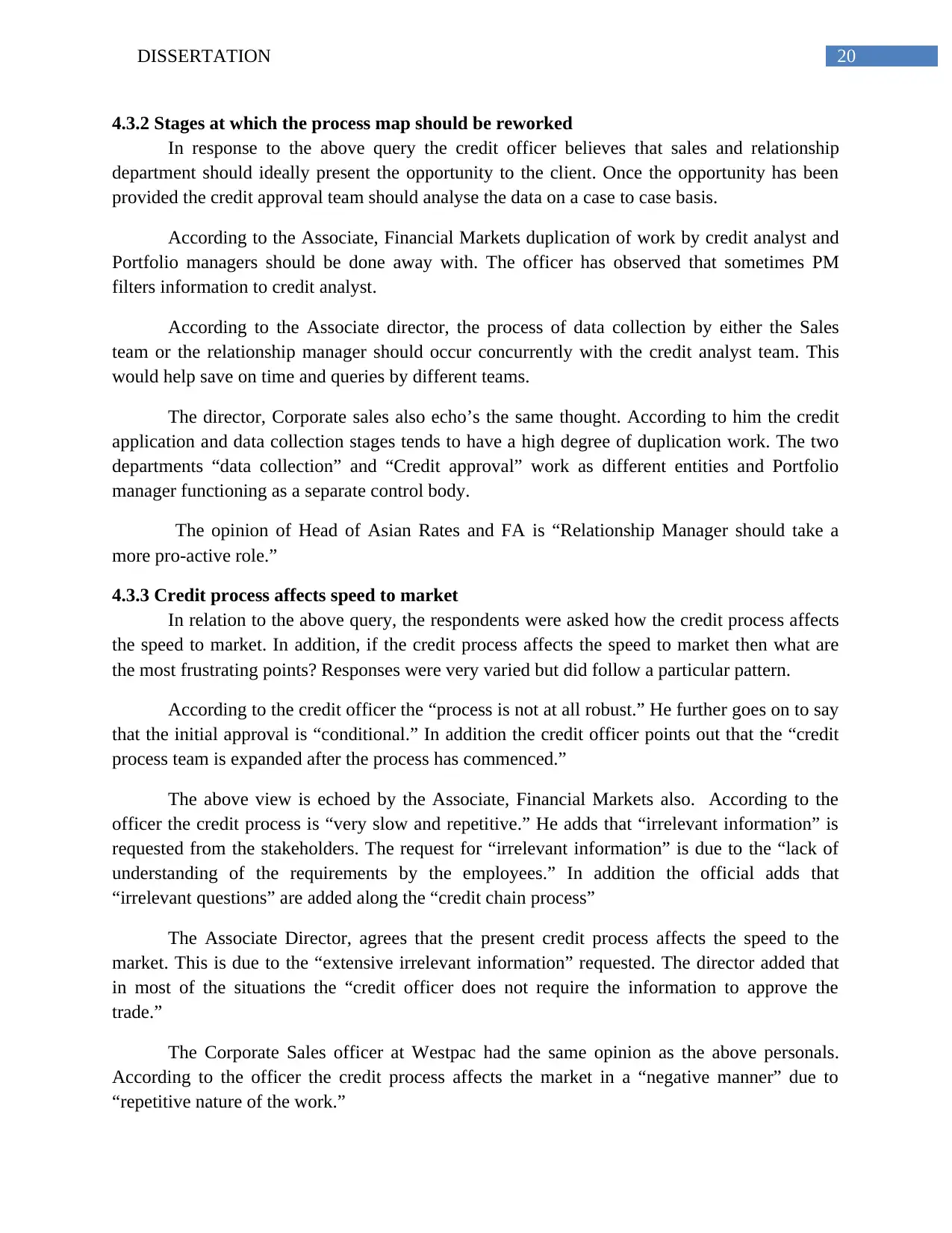
20DISSERTATION
4.3.2 Stages at which the process map should be reworked
In response to the above query the credit officer believes that sales and relationship
department should ideally present the opportunity to the client. Once the opportunity has been
provided the credit approval team should analyse the data on a case to case basis.
According to the Associate, Financial Markets duplication of work by credit analyst and
Portfolio managers should be done away with. The officer has observed that sometimes PM
filters information to credit analyst.
According to the Associate director, the process of data collection by either the Sales
team or the relationship manager should occur concurrently with the credit analyst team. This
would help save on time and queries by different teams.
The director, Corporate sales also echo’s the same thought. According to him the credit
application and data collection stages tends to have a high degree of duplication work. The two
departments “data collection” and “Credit approval” work as different entities and Portfolio
manager functioning as a separate control body.
The opinion of Head of Asian Rates and FA is “Relationship Manager should take a
more pro-active role.”
4.3.3 Credit process affects speed to market
In relation to the above query, the respondents were asked how the credit process affects
the speed to market. In addition, if the credit process affects the speed to market then what are
the most frustrating points? Responses were very varied but did follow a particular pattern.
According to the credit officer the “process is not at all robust.” He further goes on to say
that the initial approval is “conditional.” In addition the credit officer points out that the “credit
process team is expanded after the process has commenced.”
The above view is echoed by the Associate, Financial Markets also. According to the
officer the credit process is “very slow and repetitive.” He adds that “irrelevant information” is
requested from the stakeholders. The request for “irrelevant information” is due to the “lack of
understanding of the requirements by the employees.” In addition the official adds that
“irrelevant questions” are added along the “credit chain process”
The Associate Director, agrees that the present credit process affects the speed to the
market. This is due to the “extensive irrelevant information” requested. The director added that
in most of the situations the “credit officer does not require the information to approve the
trade.”
The Corporate Sales officer at Westpac had the same opinion as the above personals.
According to the officer the credit process affects the market in a “negative manner” due to
“repetitive nature of the work.”
4.3.2 Stages at which the process map should be reworked
In response to the above query the credit officer believes that sales and relationship
department should ideally present the opportunity to the client. Once the opportunity has been
provided the credit approval team should analyse the data on a case to case basis.
According to the Associate, Financial Markets duplication of work by credit analyst and
Portfolio managers should be done away with. The officer has observed that sometimes PM
filters information to credit analyst.
According to the Associate director, the process of data collection by either the Sales
team or the relationship manager should occur concurrently with the credit analyst team. This
would help save on time and queries by different teams.
The director, Corporate sales also echo’s the same thought. According to him the credit
application and data collection stages tends to have a high degree of duplication work. The two
departments “data collection” and “Credit approval” work as different entities and Portfolio
manager functioning as a separate control body.
The opinion of Head of Asian Rates and FA is “Relationship Manager should take a
more pro-active role.”
4.3.3 Credit process affects speed to market
In relation to the above query, the respondents were asked how the credit process affects
the speed to market. In addition, if the credit process affects the speed to market then what are
the most frustrating points? Responses were very varied but did follow a particular pattern.
According to the credit officer the “process is not at all robust.” He further goes on to say
that the initial approval is “conditional.” In addition the credit officer points out that the “credit
process team is expanded after the process has commenced.”
The above view is echoed by the Associate, Financial Markets also. According to the
officer the credit process is “very slow and repetitive.” He adds that “irrelevant information” is
requested from the stakeholders. The request for “irrelevant information” is due to the “lack of
understanding of the requirements by the employees.” In addition the official adds that
“irrelevant questions” are added along the “credit chain process”
The Associate Director, agrees that the present credit process affects the speed to the
market. This is due to the “extensive irrelevant information” requested. The director added that
in most of the situations the “credit officer does not require the information to approve the
trade.”
The Corporate Sales officer at Westpac had the same opinion as the above personals.
According to the officer the credit process affects the market in a “negative manner” due to
“repetitive nature of the work.”
You're viewing a preview
Unlock full access by subscribing today!
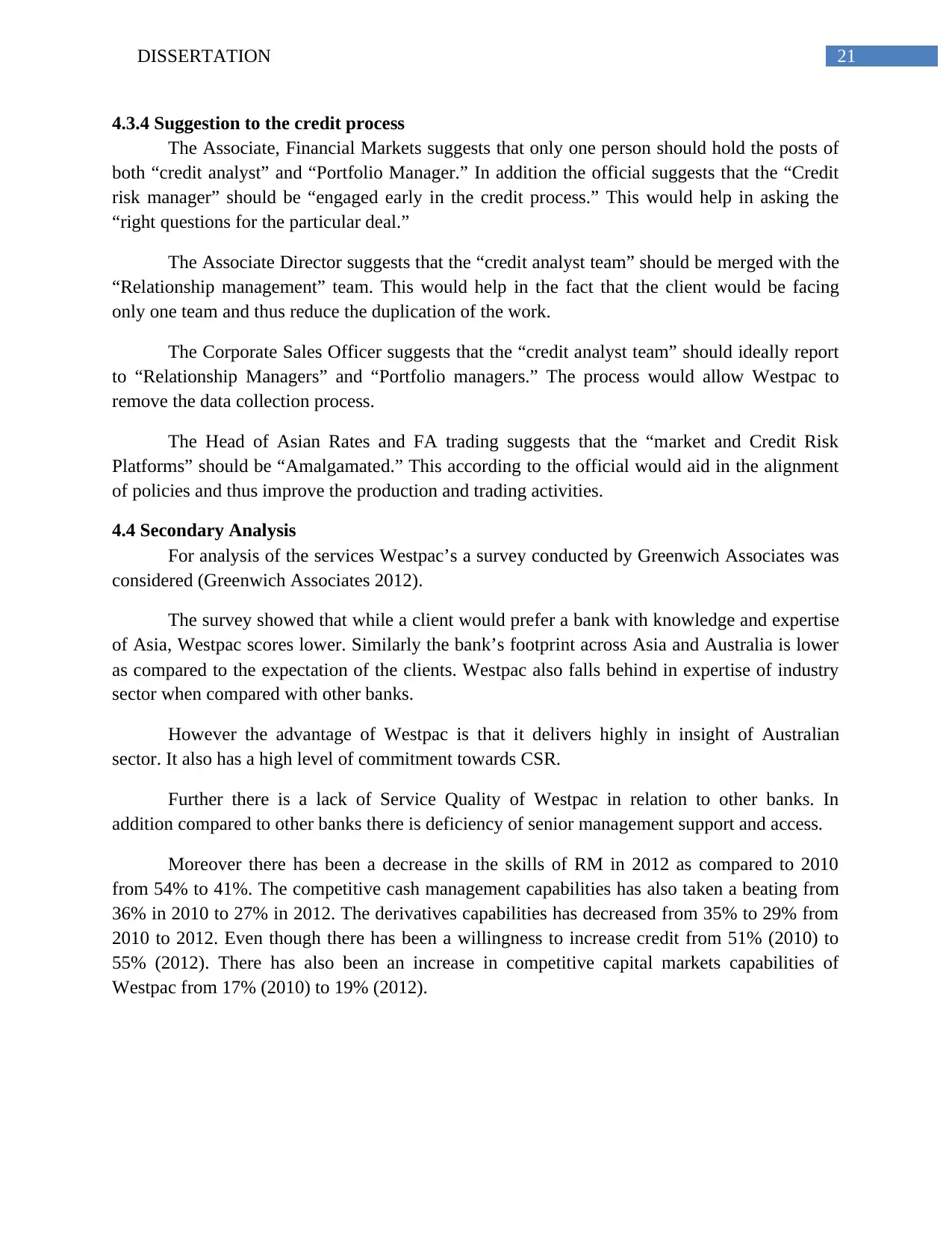
21DISSERTATION
4.3.4 Suggestion to the credit process
The Associate, Financial Markets suggests that only one person should hold the posts of
both “credit analyst” and “Portfolio Manager.” In addition the official suggests that the “Credit
risk manager” should be “engaged early in the credit process.” This would help in asking the
“right questions for the particular deal.”
The Associate Director suggests that the “credit analyst team” should be merged with the
“Relationship management” team. This would help in the fact that the client would be facing
only one team and thus reduce the duplication of the work.
The Corporate Sales Officer suggests that the “credit analyst team” should ideally report
to “Relationship Managers” and “Portfolio managers.” The process would allow Westpac to
remove the data collection process.
The Head of Asian Rates and FA trading suggests that the “market and Credit Risk
Platforms” should be “Amalgamated.” This according to the official would aid in the alignment
of policies and thus improve the production and trading activities.
4.4 Secondary Analysis
For analysis of the services Westpac’s a survey conducted by Greenwich Associates was
considered (Greenwich Associates 2012).
The survey showed that while a client would prefer a bank with knowledge and expertise
of Asia, Westpac scores lower. Similarly the bank’s footprint across Asia and Australia is lower
as compared to the expectation of the clients. Westpac also falls behind in expertise of industry
sector when compared with other banks.
However the advantage of Westpac is that it delivers highly in insight of Australian
sector. It also has a high level of commitment towards CSR.
Further there is a lack of Service Quality of Westpac in relation to other banks. In
addition compared to other banks there is deficiency of senior management support and access.
Moreover there has been a decrease in the skills of RM in 2012 as compared to 2010
from 54% to 41%. The competitive cash management capabilities has also taken a beating from
36% in 2010 to 27% in 2012. The derivatives capabilities has decreased from 35% to 29% from
2010 to 2012. Even though there has been a willingness to increase credit from 51% (2010) to
55% (2012). There has also been an increase in competitive capital markets capabilities of
Westpac from 17% (2010) to 19% (2012).
4.3.4 Suggestion to the credit process
The Associate, Financial Markets suggests that only one person should hold the posts of
both “credit analyst” and “Portfolio Manager.” In addition the official suggests that the “Credit
risk manager” should be “engaged early in the credit process.” This would help in asking the
“right questions for the particular deal.”
The Associate Director suggests that the “credit analyst team” should be merged with the
“Relationship management” team. This would help in the fact that the client would be facing
only one team and thus reduce the duplication of the work.
The Corporate Sales Officer suggests that the “credit analyst team” should ideally report
to “Relationship Managers” and “Portfolio managers.” The process would allow Westpac to
remove the data collection process.
The Head of Asian Rates and FA trading suggests that the “market and Credit Risk
Platforms” should be “Amalgamated.” This according to the official would aid in the alignment
of policies and thus improve the production and trading activities.
4.4 Secondary Analysis
For analysis of the services Westpac’s a survey conducted by Greenwich Associates was
considered (Greenwich Associates 2012).
The survey showed that while a client would prefer a bank with knowledge and expertise
of Asia, Westpac scores lower. Similarly the bank’s footprint across Asia and Australia is lower
as compared to the expectation of the clients. Westpac also falls behind in expertise of industry
sector when compared with other banks.
However the advantage of Westpac is that it delivers highly in insight of Australian
sector. It also has a high level of commitment towards CSR.
Further there is a lack of Service Quality of Westpac in relation to other banks. In
addition compared to other banks there is deficiency of senior management support and access.
Moreover there has been a decrease in the skills of RM in 2012 as compared to 2010
from 54% to 41%. The competitive cash management capabilities has also taken a beating from
36% in 2010 to 27% in 2012. The derivatives capabilities has decreased from 35% to 29% from
2010 to 2012. Even though there has been a willingness to increase credit from 51% (2010) to
55% (2012). There has also been an increase in competitive capital markets capabilities of
Westpac from 17% (2010) to 19% (2012).
Paraphrase This Document
Need a fresh take? Get an instant paraphrase of this document with our AI Paraphraser
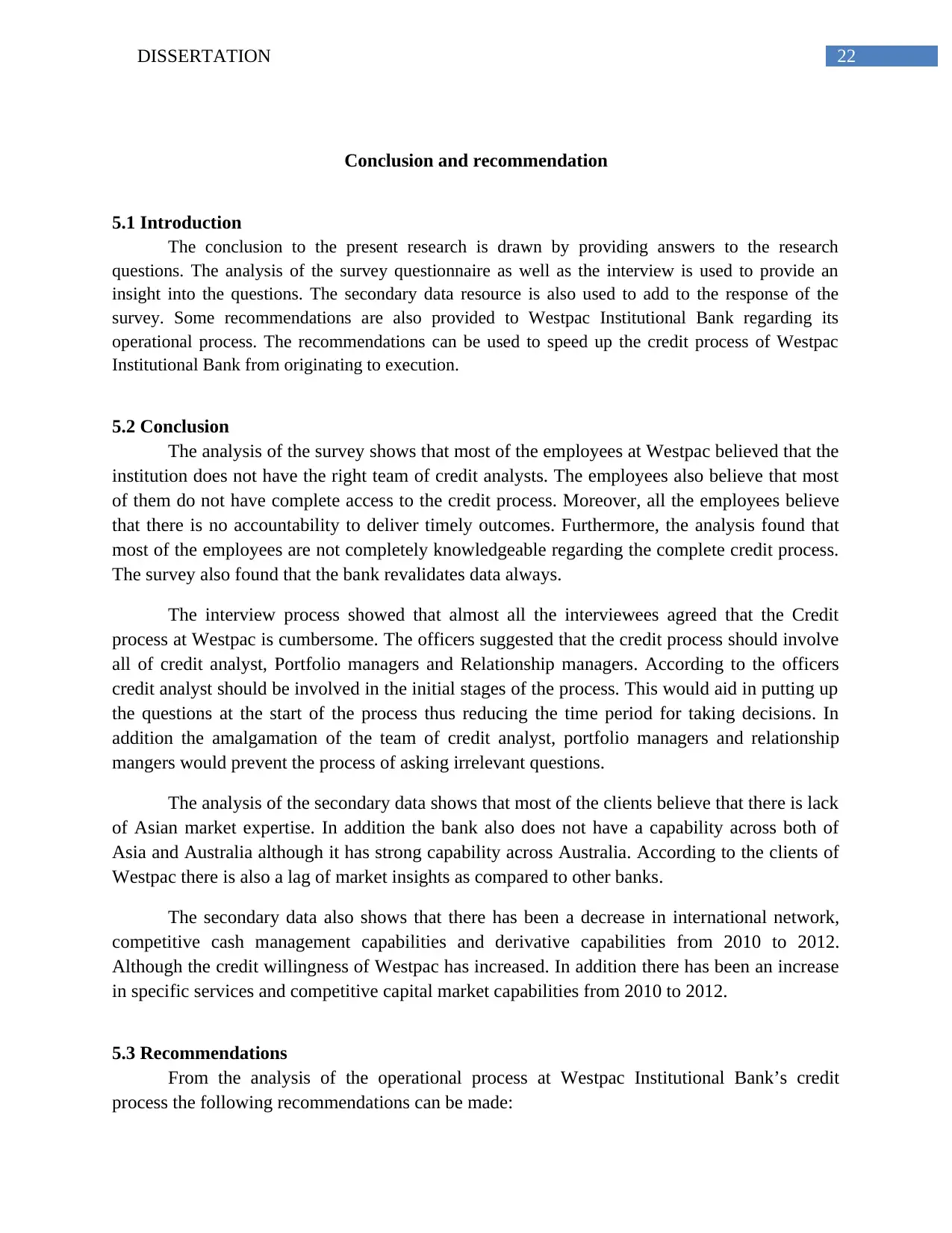
22DISSERTATION
Conclusion and recommendation
5.1 Introduction
The conclusion to the present research is drawn by providing answers to the research
questions. The analysis of the survey questionnaire as well as the interview is used to provide an
insight into the questions. The secondary data resource is also used to add to the response of the
survey. Some recommendations are also provided to Westpac Institutional Bank regarding its
operational process. The recommendations can be used to speed up the credit process of Westpac
Institutional Bank from originating to execution.
5.2 Conclusion
The analysis of the survey shows that most of the employees at Westpac believed that the
institution does not have the right team of credit analysts. The employees also believe that most
of them do not have complete access to the credit process. Moreover, all the employees believe
that there is no accountability to deliver timely outcomes. Furthermore, the analysis found that
most of the employees are not completely knowledgeable regarding the complete credit process.
The survey also found that the bank revalidates data always.
The interview process showed that almost all the interviewees agreed that the Credit
process at Westpac is cumbersome. The officers suggested that the credit process should involve
all of credit analyst, Portfolio managers and Relationship managers. According to the officers
credit analyst should be involved in the initial stages of the process. This would aid in putting up
the questions at the start of the process thus reducing the time period for taking decisions. In
addition the amalgamation of the team of credit analyst, portfolio managers and relationship
mangers would prevent the process of asking irrelevant questions.
The analysis of the secondary data shows that most of the clients believe that there is lack
of Asian market expertise. In addition the bank also does not have a capability across both of
Asia and Australia although it has strong capability across Australia. According to the clients of
Westpac there is also a lag of market insights as compared to other banks.
The secondary data also shows that there has been a decrease in international network,
competitive cash management capabilities and derivative capabilities from 2010 to 2012.
Although the credit willingness of Westpac has increased. In addition there has been an increase
in specific services and competitive capital market capabilities from 2010 to 2012.
5.3 Recommendations
From the analysis of the operational process at Westpac Institutional Bank’s credit
process the following recommendations can be made:
Conclusion and recommendation
5.1 Introduction
The conclusion to the present research is drawn by providing answers to the research
questions. The analysis of the survey questionnaire as well as the interview is used to provide an
insight into the questions. The secondary data resource is also used to add to the response of the
survey. Some recommendations are also provided to Westpac Institutional Bank regarding its
operational process. The recommendations can be used to speed up the credit process of Westpac
Institutional Bank from originating to execution.
5.2 Conclusion
The analysis of the survey shows that most of the employees at Westpac believed that the
institution does not have the right team of credit analysts. The employees also believe that most
of them do not have complete access to the credit process. Moreover, all the employees believe
that there is no accountability to deliver timely outcomes. Furthermore, the analysis found that
most of the employees are not completely knowledgeable regarding the complete credit process.
The survey also found that the bank revalidates data always.
The interview process showed that almost all the interviewees agreed that the Credit
process at Westpac is cumbersome. The officers suggested that the credit process should involve
all of credit analyst, Portfolio managers and Relationship managers. According to the officers
credit analyst should be involved in the initial stages of the process. This would aid in putting up
the questions at the start of the process thus reducing the time period for taking decisions. In
addition the amalgamation of the team of credit analyst, portfolio managers and relationship
mangers would prevent the process of asking irrelevant questions.
The analysis of the secondary data shows that most of the clients believe that there is lack
of Asian market expertise. In addition the bank also does not have a capability across both of
Asia and Australia although it has strong capability across Australia. According to the clients of
Westpac there is also a lag of market insights as compared to other banks.
The secondary data also shows that there has been a decrease in international network,
competitive cash management capabilities and derivative capabilities from 2010 to 2012.
Although the credit willingness of Westpac has increased. In addition there has been an increase
in specific services and competitive capital market capabilities from 2010 to 2012.
5.3 Recommendations
From the analysis of the operational process at Westpac Institutional Bank’s credit
process the following recommendations can be made:
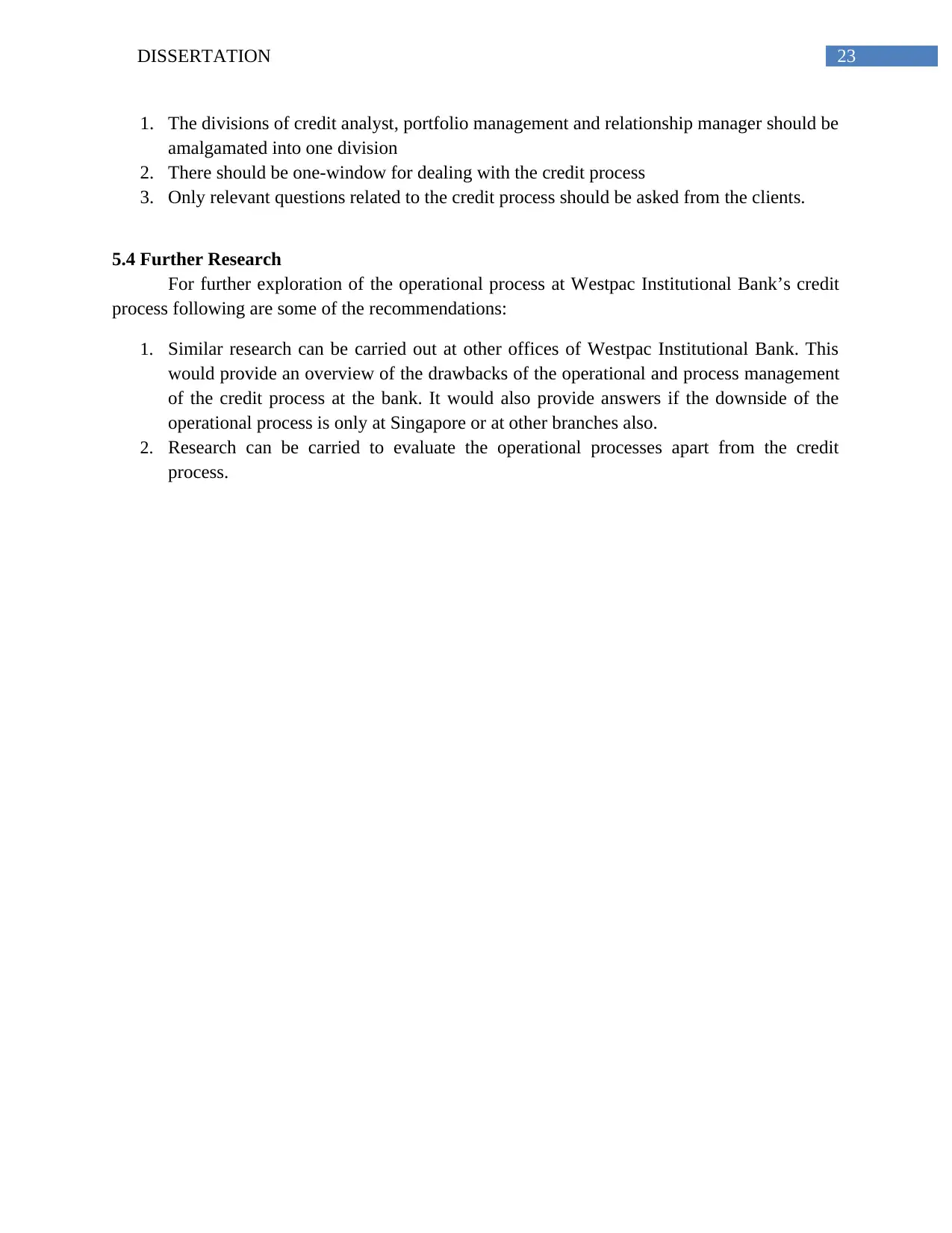
23DISSERTATION
1. The divisions of credit analyst, portfolio management and relationship manager should be
amalgamated into one division
2. There should be one-window for dealing with the credit process
3. Only relevant questions related to the credit process should be asked from the clients.
5.4 Further Research
For further exploration of the operational process at Westpac Institutional Bank’s credit
process following are some of the recommendations:
1. Similar research can be carried out at other offices of Westpac Institutional Bank. This
would provide an overview of the drawbacks of the operational and process management
of the credit process at the bank. It would also provide answers if the downside of the
operational process is only at Singapore or at other branches also.
2. Research can be carried to evaluate the operational processes apart from the credit
process.
1. The divisions of credit analyst, portfolio management and relationship manager should be
amalgamated into one division
2. There should be one-window for dealing with the credit process
3. Only relevant questions related to the credit process should be asked from the clients.
5.4 Further Research
For further exploration of the operational process at Westpac Institutional Bank’s credit
process following are some of the recommendations:
1. Similar research can be carried out at other offices of Westpac Institutional Bank. This
would provide an overview of the drawbacks of the operational and process management
of the credit process at the bank. It would also provide answers if the downside of the
operational process is only at Singapore or at other branches also.
2. Research can be carried to evaluate the operational processes apart from the credit
process.
You're viewing a preview
Unlock full access by subscribing today!
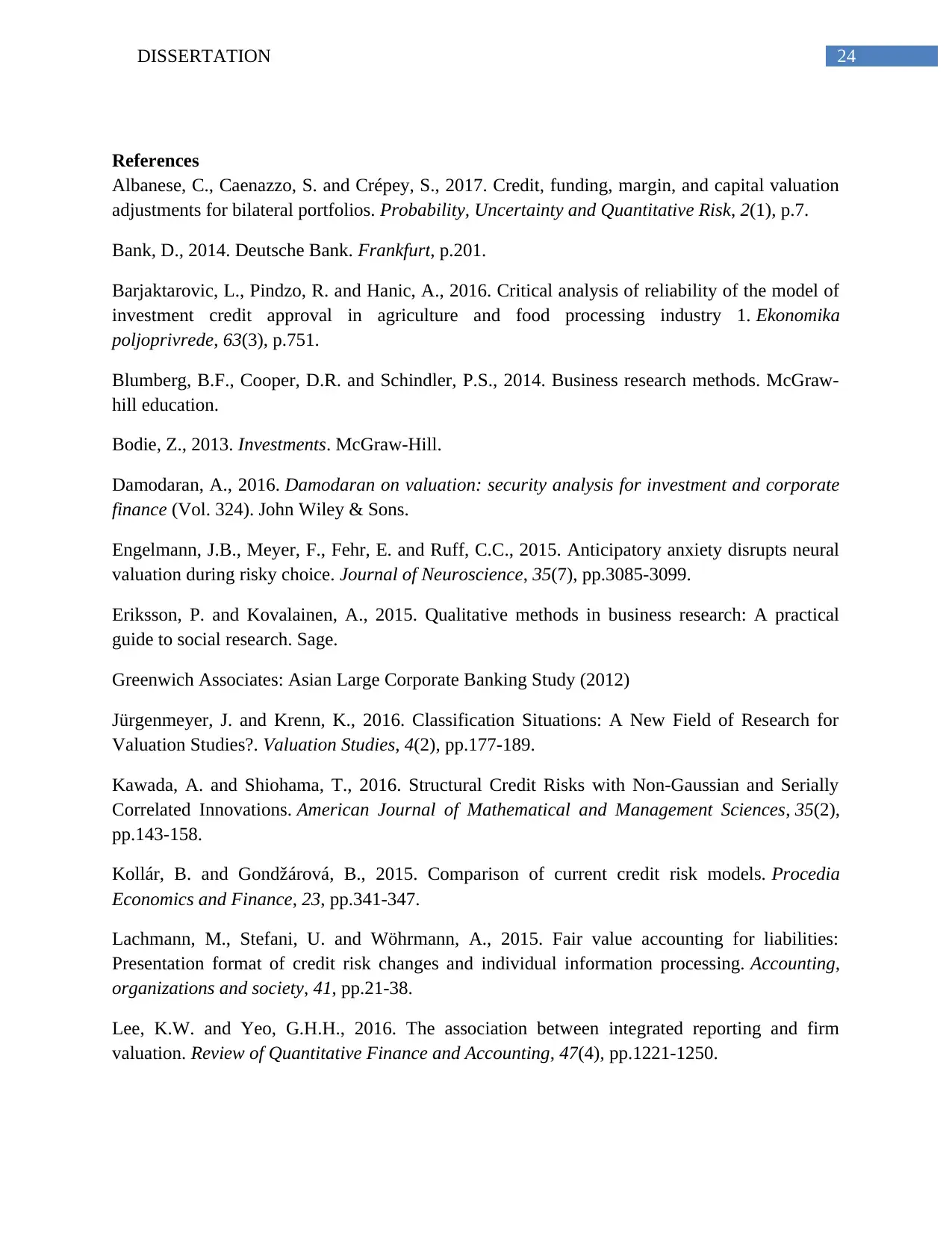
24DISSERTATION
References
Albanese, C., Caenazzo, S. and Crépey, S., 2017. Credit, funding, margin, and capital valuation
adjustments for bilateral portfolios. Probability, Uncertainty and Quantitative Risk, 2(1), p.7.
Bank, D., 2014. Deutsche Bank. Frankfurt, p.201.
Barjaktarovic, L., Pindzo, R. and Hanic, A., 2016. Critical analysis of reliability of the model of
investment credit approval in agriculture and food processing industry 1. Ekonomika
poljoprivrede, 63(3), p.751.
Blumberg, B.F., Cooper, D.R. and Schindler, P.S., 2014. Business research methods. McGraw-
hill education.
Bodie, Z., 2013. Investments. McGraw-Hill.
Damodaran, A., 2016. Damodaran on valuation: security analysis for investment and corporate
finance (Vol. 324). John Wiley & Sons.
Engelmann, J.B., Meyer, F., Fehr, E. and Ruff, C.C., 2015. Anticipatory anxiety disrupts neural
valuation during risky choice. Journal of Neuroscience, 35(7), pp.3085-3099.
Eriksson, P. and Kovalainen, A., 2015. Qualitative methods in business research: A practical
guide to social research. Sage.
Greenwich Associates: Asian Large Corporate Banking Study (2012)
Jürgenmeyer, J. and Krenn, K., 2016. Classification Situations: A New Field of Research for
Valuation Studies?. Valuation Studies, 4(2), pp.177-189.
Kawada, A. and Shiohama, T., 2016. Structural Credit Risks with Non-Gaussian and Serially
Correlated Innovations. American Journal of Mathematical and Management Sciences, 35(2),
pp.143-158.
Kollár, B. and Gondžárová, B., 2015. Comparison of current credit risk models. Procedia
Economics and Finance, 23, pp.341-347.
Lachmann, M., Stefani, U. and Wöhrmann, A., 2015. Fair value accounting for liabilities:
Presentation format of credit risk changes and individual information processing. Accounting,
organizations and society, 41, pp.21-38.
Lee, K.W. and Yeo, G.H.H., 2016. The association between integrated reporting and firm
valuation. Review of Quantitative Finance and Accounting, 47(4), pp.1221-1250.
References
Albanese, C., Caenazzo, S. and Crépey, S., 2017. Credit, funding, margin, and capital valuation
adjustments for bilateral portfolios. Probability, Uncertainty and Quantitative Risk, 2(1), p.7.
Bank, D., 2014. Deutsche Bank. Frankfurt, p.201.
Barjaktarovic, L., Pindzo, R. and Hanic, A., 2016. Critical analysis of reliability of the model of
investment credit approval in agriculture and food processing industry 1. Ekonomika
poljoprivrede, 63(3), p.751.
Blumberg, B.F., Cooper, D.R. and Schindler, P.S., 2014. Business research methods. McGraw-
hill education.
Bodie, Z., 2013. Investments. McGraw-Hill.
Damodaran, A., 2016. Damodaran on valuation: security analysis for investment and corporate
finance (Vol. 324). John Wiley & Sons.
Engelmann, J.B., Meyer, F., Fehr, E. and Ruff, C.C., 2015. Anticipatory anxiety disrupts neural
valuation during risky choice. Journal of Neuroscience, 35(7), pp.3085-3099.
Eriksson, P. and Kovalainen, A., 2015. Qualitative methods in business research: A practical
guide to social research. Sage.
Greenwich Associates: Asian Large Corporate Banking Study (2012)
Jürgenmeyer, J. and Krenn, K., 2016. Classification Situations: A New Field of Research for
Valuation Studies?. Valuation Studies, 4(2), pp.177-189.
Kawada, A. and Shiohama, T., 2016. Structural Credit Risks with Non-Gaussian and Serially
Correlated Innovations. American Journal of Mathematical and Management Sciences, 35(2),
pp.143-158.
Kollár, B. and Gondžárová, B., 2015. Comparison of current credit risk models. Procedia
Economics and Finance, 23, pp.341-347.
Lachmann, M., Stefani, U. and Wöhrmann, A., 2015. Fair value accounting for liabilities:
Presentation format of credit risk changes and individual information processing. Accounting,
organizations and society, 41, pp.21-38.
Lee, K.W. and Yeo, G.H.H., 2016. The association between integrated reporting and firm
valuation. Review of Quantitative Finance and Accounting, 47(4), pp.1221-1250.
Paraphrase This Document
Need a fresh take? Get an instant paraphrase of this document with our AI Paraphraser
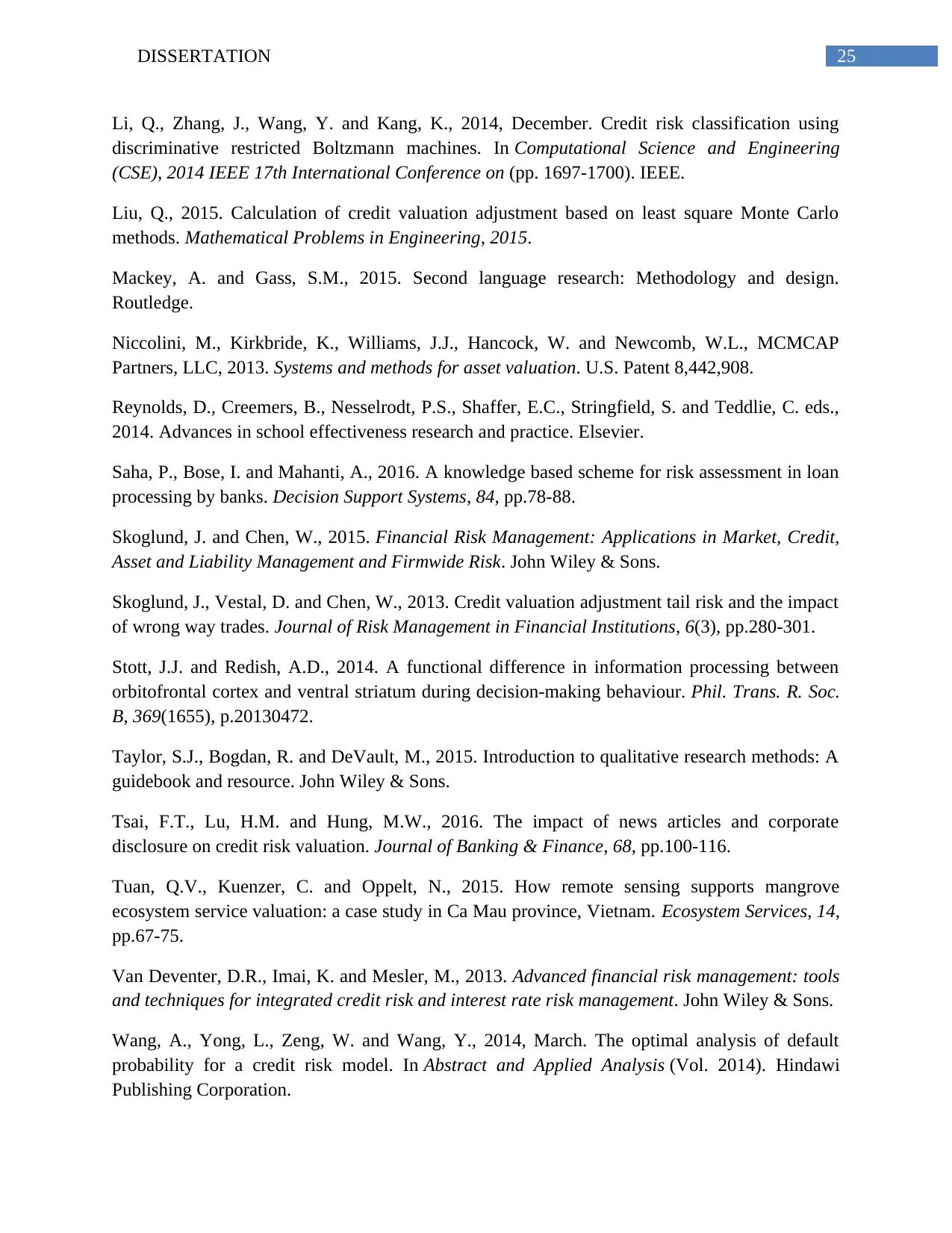
25DISSERTATION
Li, Q., Zhang, J., Wang, Y. and Kang, K., 2014, December. Credit risk classification using
discriminative restricted Boltzmann machines. In Computational Science and Engineering
(CSE), 2014 IEEE 17th International Conference on (pp. 1697-1700). IEEE.
Liu, Q., 2015. Calculation of credit valuation adjustment based on least square Monte Carlo
methods. Mathematical Problems in Engineering, 2015.
Mackey, A. and Gass, S.M., 2015. Second language research: Methodology and design.
Routledge.
Niccolini, M., Kirkbride, K., Williams, J.J., Hancock, W. and Newcomb, W.L., MCMCAP
Partners, LLC, 2013. Systems and methods for asset valuation. U.S. Patent 8,442,908.
Reynolds, D., Creemers, B., Nesselrodt, P.S., Shaffer, E.C., Stringfield, S. and Teddlie, C. eds.,
2014. Advances in school effectiveness research and practice. Elsevier.
Saha, P., Bose, I. and Mahanti, A., 2016. A knowledge based scheme for risk assessment in loan
processing by banks. Decision Support Systems, 84, pp.78-88.
Skoglund, J. and Chen, W., 2015. Financial Risk Management: Applications in Market, Credit,
Asset and Liability Management and Firmwide Risk. John Wiley & Sons.
Skoglund, J., Vestal, D. and Chen, W., 2013. Credit valuation adjustment tail risk and the impact
of wrong way trades. Journal of Risk Management in Financial Institutions, 6(3), pp.280-301.
Stott, J.J. and Redish, A.D., 2014. A functional difference in information processing between
orbitofrontal cortex and ventral striatum during decision-making behaviour. Phil. Trans. R. Soc.
B, 369(1655), p.20130472.
Taylor, S.J., Bogdan, R. and DeVault, M., 2015. Introduction to qualitative research methods: A
guidebook and resource. John Wiley & Sons.
Tsai, F.T., Lu, H.M. and Hung, M.W., 2016. The impact of news articles and corporate
disclosure on credit risk valuation. Journal of Banking & Finance, 68, pp.100-116.
Tuan, Q.V., Kuenzer, C. and Oppelt, N., 2015. How remote sensing supports mangrove
ecosystem service valuation: a case study in Ca Mau province, Vietnam. Ecosystem Services, 14,
pp.67-75.
Van Deventer, D.R., Imai, K. and Mesler, M., 2013. Advanced financial risk management: tools
and techniques for integrated credit risk and interest rate risk management. John Wiley & Sons.
Wang, A., Yong, L., Zeng, W. and Wang, Y., 2014, March. The optimal analysis of default
probability for a credit risk model. In Abstract and Applied Analysis (Vol. 2014). Hindawi
Publishing Corporation.
Li, Q., Zhang, J., Wang, Y. and Kang, K., 2014, December. Credit risk classification using
discriminative restricted Boltzmann machines. In Computational Science and Engineering
(CSE), 2014 IEEE 17th International Conference on (pp. 1697-1700). IEEE.
Liu, Q., 2015. Calculation of credit valuation adjustment based on least square Monte Carlo
methods. Mathematical Problems in Engineering, 2015.
Mackey, A. and Gass, S.M., 2015. Second language research: Methodology and design.
Routledge.
Niccolini, M., Kirkbride, K., Williams, J.J., Hancock, W. and Newcomb, W.L., MCMCAP
Partners, LLC, 2013. Systems and methods for asset valuation. U.S. Patent 8,442,908.
Reynolds, D., Creemers, B., Nesselrodt, P.S., Shaffer, E.C., Stringfield, S. and Teddlie, C. eds.,
2014. Advances in school effectiveness research and practice. Elsevier.
Saha, P., Bose, I. and Mahanti, A., 2016. A knowledge based scheme for risk assessment in loan
processing by banks. Decision Support Systems, 84, pp.78-88.
Skoglund, J. and Chen, W., 2015. Financial Risk Management: Applications in Market, Credit,
Asset and Liability Management and Firmwide Risk. John Wiley & Sons.
Skoglund, J., Vestal, D. and Chen, W., 2013. Credit valuation adjustment tail risk and the impact
of wrong way trades. Journal of Risk Management in Financial Institutions, 6(3), pp.280-301.
Stott, J.J. and Redish, A.D., 2014. A functional difference in information processing between
orbitofrontal cortex and ventral striatum during decision-making behaviour. Phil. Trans. R. Soc.
B, 369(1655), p.20130472.
Taylor, S.J., Bogdan, R. and DeVault, M., 2015. Introduction to qualitative research methods: A
guidebook and resource. John Wiley & Sons.
Tsai, F.T., Lu, H.M. and Hung, M.W., 2016. The impact of news articles and corporate
disclosure on credit risk valuation. Journal of Banking & Finance, 68, pp.100-116.
Tuan, Q.V., Kuenzer, C. and Oppelt, N., 2015. How remote sensing supports mangrove
ecosystem service valuation: a case study in Ca Mau province, Vietnam. Ecosystem Services, 14,
pp.67-75.
Van Deventer, D.R., Imai, K. and Mesler, M., 2013. Advanced financial risk management: tools
and techniques for integrated credit risk and interest rate risk management. John Wiley & Sons.
Wang, A., Yong, L., Zeng, W. and Wang, Y., 2014, March. The optimal analysis of default
probability for a credit risk model. In Abstract and Applied Analysis (Vol. 2014). Hindawi
Publishing Corporation.

26DISSERTATION
Źróbek, S. and Grzesik, C., 2013. Modern challenges facing the valuation profession and allied
university education in Poland. Real Estate Management and Valuation, 21(1), pp.14-18.
Źróbek, S. and Grzesik, C., 2013. Modern challenges facing the valuation profession and allied
university education in Poland. Real Estate Management and Valuation, 21(1), pp.14-18.
You're viewing a preview
Unlock full access by subscribing today!
1 out of 27
Related Documents
Your All-in-One AI-Powered Toolkit for Academic Success.
+13062052269
info@desklib.com
Available 24*7 on WhatsApp / Email
![[object Object]](/_next/static/media/star-bottom.7253800d.svg)
Unlock your academic potential
© 2024 | Zucol Services PVT LTD | All rights reserved.





